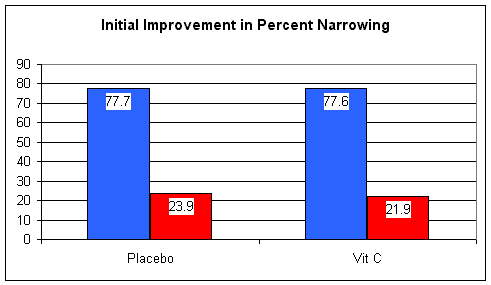
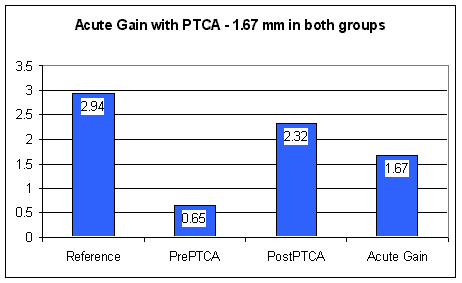
Return to Medical Topics Home Page
Vitamin C
1. Vitamin C decreases 10-year event rate and death rate by 40-60%
2. Vitamin C decreases the need for repeat angioplasty by 57%
3. Vitamin C reverses endothelial dysfunction
4. Vitamin C improves outcome and protects against atrial fibrillation following bypass surgery
5. Vitamin C improves outcome following heart attack
6. Vitamin C retards progression of atherosclerosis
7. Vitamin C helps with blood pressure control
8. Lipoprotein(a) - Archrival and nemesis of Vitamin C
9. Vitamin C deficiency is associated with a high CRP and more severe vascular disease
10. Vitamin C lowers cholesterol and Lipoprotein(a) levels
11. Vitamin C gets the lead out
12. Vitamin C: How much should you take and how should you take it?
13. Vitamin C as a member of your Antioxidant Defense Team - Understanding Nutritional Medicine
14. Vitamin C blocks Nitrate Tolerance
15. Vitamin C is an inverse risk factor
16. Summary
1. Effect of Vitamin C on Atherosclerosis Progression and Cardiovascular Events in a Ten-Year Randomized Study (San Valentino). Nicolaides, A, et al. Journal of the American College of Cardiology Abstract Issue 3/6/02, Abstract 863-4
The San Valentino research group, working in Italy and Great Britain, set out to answer two questions:
First - Is the presence of mild to moderate narrowing in the carotid and lower extremity arteries a harbinger of worse things to come (adverse cardiovascular events) over a 10-year period?
Second - Can Vitamin C supplementation decrease this risk?
Vascular ultrasound allows us to image arteries and measure their diameter; if a partial blockage is present, due to atherosclerotic vascular disease, it can be localized and quantified. The coronary arteries that serve the heart are too deep within the chest to allow ultrasound imaging, but it is easy to visualize the carotid arteries, in the front of the neck, and the femoral arteries, in the groin.
Vascular disease shows itself to the patient and to the physician, when a high-grade narrowing in one artery chokes off blood flow to the organ that it serves, producing an adverse event or symptom, but atherosclerotic vascular disease is really a disease of the entire circulation, affecting all of our arteries to some degree. If a patient has a high-grade coronary artery narrowing, we typically see some blockage in the arteries serving the brain and lower extremities, and visa versa. It stands to reason that arterial blockage severe enough to produce a vascular event (heart attack, stroke, gangrene, need for revascularization surgery, etc.) would be proceeded years earlier by the presence of a low-grade blockage, and that the presence of a low-grade blockage in the arteries to the brain or lower extremity at one point in time would be associated with an increased likelihood that the individual so affected would experience an adverse cardiovascular event in the future. If we can identify, with no risk and minimal expense, which individuals within a population are most likely to get into trouble in the future, then we can focus our preventive efforts on these "at risk" individuals.
Dr. Nicolaides and associates set out to study this early disease-future risk association. They carried out carotid artery (the vessels in the front of the neck that carry blood to the front of the brain) and femoral artery (vessels to the lower extremities) ultrasound studies on 13,221 low risk, healthy subjects who were free of symptomatic cardiovascular disease. They classified the subjects into one of four groups, depending on the degree of vascular narrowing observed. Class I subjects had normal vessels, Class II had mild vascular disease, or "plaqueing"; Class III subjects demonstrated moderate narrowings, not involving 50% of the vessel's diameter, while Class IV patients had ³ 50%, possibly flow-restrictive narrowings. They followed these subjects over time. No specific interventions were carried out; basically Nicolaides wanted to see what the "natural history" of these subjects, with their differing degrees of atherosclerotic disease burden at baseline, would be. When 10,000 subjects completed 10 years of follow-up, the study was closed and this report was generated. The table below gives you the percentage of subjects in each vascular disease category, as well as their 10-year event and mortality rates.
| Class | Description | Percentage | 10-yr Event Rate | Death Rate |
| I | Normal Wall | 80% | .13% | 0% |
| II | Plaqueing | 9% | 9% | 0% |
| III | < 50% Narrowing | 6% |
39% |
2% |
| IV | > 50% Narrowing | 5% | 81% | 11% |
Vascular ultrasound does predict the future! A Class III or IV narrowing was present in only 11% of these asymptomatic European subjects, but this group accounted for 87% of the 10-year cardiovascular events and 100% of the cardiovascular mortality. Minor plaqueing subjects could still get into trouble, but they didn't die, while if your vessels were normal, then, from the 10-year perspective, it appears that you are home free. Following this concept, early vascular screening campaigns have been launched; individuals with abnormal scans are urged to work with their health care providers on an anti-atherosclerotic prevention program. This makes sense; work with the people who need your help!
Individuals at risk have been identified. Now, on to the second question: What can we do to decrease this risk? How can we favorably affect the natural history of cardiovascular disease and protect ourselves from it's consequences? Nicolaides hypothesized that Vitamin C supplementation might favorably affect the natural history of cardiovascular disease. The second part of the study tested out his prediction.
1032 subjects (an equal number from each baseline vascular disease class), were randomized to receive no supplementation, or to receive Vitamin C, 1000 mg/day, over 10 years. These subjects underwent a repeat ultrasound, looking for progression of their disease from one class into the next, but no other interventions were carried out. Nicolaides knew what the natural history of vascular disease was from his 10,000 subjects; here he wanted to see whether Vitamin C would modify it. His 10-year findings are presented in the tables below:
|
10-Year Progression Rate |
Progression by ³ 1 Class |
||
|
Class |
Description |
No Vitamin C |
Vit C 1000 mg. |
|
I |
Normal Wall |
none |
none |
|
II |
Plaqueing |
13% |
3% |
|
III |
< 50% |
34% |
6% |
|
IV |
> 50% |
67% |
21% |
Vitamin C obviously decreases vascular disease progression over 10 years. What does this mean to you? Well, if you are middle aged and your arteries are normal to begin with, then it appears that 10 years later, your arteries will remain normal, whether you do or do not take Vitamin C. If you are not broke, than we can't fix you, no matter how hard we try. Good for you; don't get hit by any cars while jogging and you'll do fine. However, if you have early cardiovascular disease, plaqueing on your ultrasound, then 10 years later 13 out of 100 of you will have a moderate, <50% narrowing, but if you simply take Vitamin C, than only 3 out of 100 of you will worsen their vascular disease to this degree. The protective affect of Vitamin C on disease progression is present at all disease levels, and becomes more meaningful at the higher disease levels. 2/3rds of the subjects with >50% narrowings will develop a new >50% narrowing over 10 years, if left on their own, while if they take Vitamin C, only 21% will progress to this degree. So Vitamin C slows down or prevents worsening of the ultrasound picture. That's nice, but what affect will Vitamin C have on cardiovascular event rates, what patients care about most?
|
10-Year Event Rate |
Cardiovascular Event |
||
|
Class |
Description |
No Vitamin C |
Vit C 1000 mg. |
|
I |
Normal Wall |
< 1% |
< 1% |
|
II |
Plaqueing |
8% |
3% |
|
III |
< 50% |
38% |
8% |
|
IV |
> 50% |
82% |
44% |
If your arteries are normal, than you are not broke. You are not going to experience an event. 10 years ago I told patients that mild plaqueing on their ultrasound was "normal for their age". Boy was I wrong; 8% of these individuals will experience an adverse event over 10 years, but their risk drops to 3% if they take Vitamin C. If I saw a < 50% narrowing I would say something like: "Only a moderate narrowing is present; you don't need surgery and you are OK". Well, you might be OK for a while, but over 10 years 38 out of 100 of you will experience an adverse event, but the risk falls dramatically, to only 8 out of 100 if I had put you on Vitamin C. Look at what happens in the advanced disease group; Vitamin C spares 38 out of 100 people an adverse event, decreasing event rate from 82% to 44%. No prescription drug can give you this benefit. Prescription drugs cost a lot and produce side-effects; Vitamin C costs pennies a day and at this dosing level is essentially side-effect free. Oh, and by the way,
10-year mortality was reduced by 43% with Vitamin C.
2. Possible Prevention of Postangioplasty Restenosis by Ascorbic Acid. Tomoda, H, et al American Journal of Cardiology 1996 Dec, 1;78(11)1284-86.
77 of our initial 181 EECP patients had undergone a total of 141 prior angioplasty or stent procedures. Angioplasty is a wonderful procedure; the narrowed artery is opened up without surgery. You go home the next day, and 1 day later you're back on the golf course. The problem with this approach, well understood by MDs and patients alike, is the potential for renarrowing of the dilated vessel, termed restenosis, which occurs in 30-50% of the vessels dilated. The use of vascular stents decreases, but does not eliminate, the problem of restenosis. Re-stenting with a radioactive stent can then be carried out, but introduces a new set of problems, or the patient can undergo bypass surgery or EECP, depending on their overall situation. Antibiotic-coated stents hold promise as a solution to the restenosis problem, but at present are not available for wide-spread use. Our post-angioplasty restenosis patients have done well with EECP (please see PATIENT OUTCOMES and CASE STUDIES sections), but an even better approach would be to prevent the post-angioplasty restenosis in the first place.
Lipoprotein(a), the sticky or "ugly" cholesterol, serves as a vascular wall repair particle. Balloon angioplasty does traumatize the vascular wall, and Lipoprotein(a) rushes in to do it's job. Lipoprotein(a) can do too good a job "repairing" the artery, and this leads to restenosis. Individuals with high Lipoprotein(a) levels are thus at increased risk for restenosis following angioplasty. In a representative study, patients with post-angioplasty restenosis had an average Lipoprotein(a) level of 19 mg/dl, while those who did not renarrow had an average level of 7. In another study, patients with Lipoprotein(a) levels above 40 were found to be 11 times more likely to experience post-angioplasty restenosis than were otherwise similar patients with levels below 4. Free radical inflammation occurs within the vessel wall following successful angioplasty, and also plays a role in the restenosing process. Vitamin C squelches free radical inflammation, and is one of the few treatments that we have for an elevated Lipoprotein(a). Dr. Tomoda, and his group in Japan, thus hypothesized that Vitamin C supplementation might decrease the rate of restenosis following angioplasty.
To test this hypothesis, Tomoda and colleagues recruited 101 patients with an initially successful angioplasty, and at random assigned them to receive either Vitamin C 250 mg twice a day, or a similar appearing placebo. At 4 months, all patients underwent repeat coronary angiography; restenosis was diagnosed if the 4 month angiogram demonstrated a > 50% narrowing at the angioplasty site. Repeat angioplasty was carried out if restenosis led to a recurrence of the patient's symptoms. So what affect, if any, did low dose Vitamin C supplementation have on restenosis rate and the need for repeat angioplasty? The charts below tell the story:


Angioplasty was equally successful in both groups. Percent narrowing decreased from around 78 to 23% in both groups; on average the diameter of the dilated vessels increased by 1.67 mm. Now, how did the vessels look at 4 months?
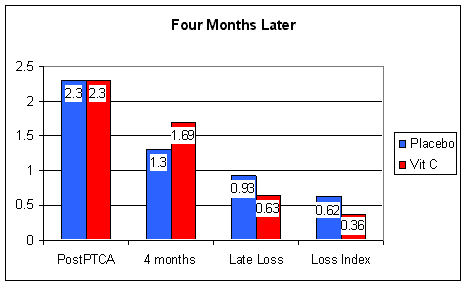
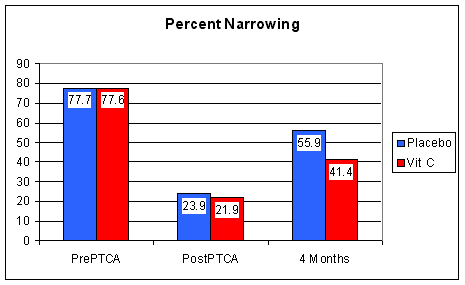
In both groups, some degree of renarrowing had occurred at 4 months, but the degree of renarrowing, or restenosis, was clearly greater in the placebo group. The placebo patients lost 2/3rds of their initial, angioplasty-related improvement; percent narrowing worsened from 24% early post-angioplasty to 56% at 4 months. The Vitamin C patients lost only 1/3 of their gain, with a 4 month percent narrowing of 41%. These are mean values for the group, and interest me as an invasive cardiologist. As a patient, you don't want further invasive intervention, so you are likely more interested in what affect, Vitamin C supplementation had on the patients' restenosis rate and need for repeat angioplasty.
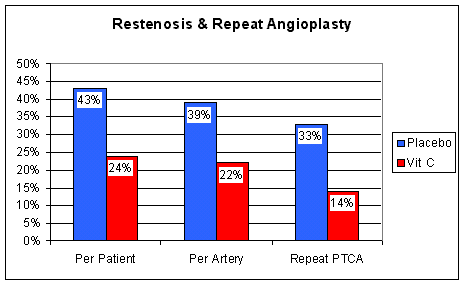 43% of the
placebo patients experienced angiographically significant restenosis at 4
months, similar to the post-angioplasty restenosis rate in other studies.
24% of the Vitamin C patients experienced restenosis. Similar percentage
values applied if you looked at restenosis rate per artery (some of the patients
had angioplasty of > 1 artery). 1/3rd of the placebo patients required
a repeat angioplasty; only 14% of the Vitamin C patients required a 2nd
procedure. Some doctors will tell you that Vitamin C is of no value, that
is will give you "expensive urine". I put all of my patients on
Vitamin C prior to angioplasty, and even prior to angiography (in case we decide
to do an angioplasty immediately following the diagnostic angiogram). I
want my patients to have "expensive urine", because repeat
angioplasties cost around $10-15,000, and Vitamin C costs only pennies per
day. Also, my patients prefer that their angioplasty sites remain
open. This paper was published in a journal that most cardiologists
subscribe to, but for reasons that are not clear to me, neither physicians or patients
are aware of Vitamin C's favorable affect of post-angioplasty restenosis - but
now you are.
43% of the
placebo patients experienced angiographically significant restenosis at 4
months, similar to the post-angioplasty restenosis rate in other studies.
24% of the Vitamin C patients experienced restenosis. Similar percentage
values applied if you looked at restenosis rate per artery (some of the patients
had angioplasty of > 1 artery). 1/3rd of the placebo patients required
a repeat angioplasty; only 14% of the Vitamin C patients required a 2nd
procedure. Some doctors will tell you that Vitamin C is of no value, that
is will give you "expensive urine". I put all of my patients on
Vitamin C prior to angioplasty, and even prior to angiography (in case we decide
to do an angioplasty immediately following the diagnostic angiogram). I
want my patients to have "expensive urine", because repeat
angioplasties cost around $10-15,000, and Vitamin C costs only pennies per
day. Also, my patients prefer that their angioplasty sites remain
open. This paper was published in a journal that most cardiologists
subscribe to, but for reasons that are not clear to me, neither physicians or patients
are aware of Vitamin C's favorable affect of post-angioplasty restenosis - but
now you are.
Vitamin C decreases restenosis by 44% and the need for repeat angioplasty by 57%!
3. Effect of Placebo Controlled Regular Ascorbic Acid Intake on Endothelial Dysfunction of Coronary Microcirculation in Hypertensive Patients. Schindler, T, et al. Circulation Abstracts from the 72nd Scientific Sessions, Abstract 3995, page I-757
Endothelial function is the most important predictor of cardiovascular health; this concept receives four hours over two sessions in our lecture series. Individuals with intact endothelial function do well, regardless of the degree of vascular disease present, while patients with severe endothelial dysfunction are essentially doomed. So what is the endothelium and how do we measure its function? The cells lining our arteries, veins, and capillaries are termed endothelial cells; they provide the "teflon coating" to our vessels, and prevent vascular wall injury, spasm, clot formation, and plaque build-up, that is, if they are functioning normally. These endothelial cells are essentially vasochemical manufacturing plants, and the most important vasochemical made by the endothelial cells is Nitric Oxide. The endothelial cells take up the amino acid arginine (obtained in the diet or as a supplement) and convert it into Nitric Oxide. Nitric Oxide is the agent that carries out the beneficial functions of the endothelium. When you take a nitroglycerin tablet, what you are doing is giving yourself a shot of Nitric Oxide, but healthy people make Nitric Oxide from arginine, that is, if their endothelial cells are healthy. Multiple studies correlate endothelial dysfunction with a poor outlook, and endothelial health with a good outlook. The pharmaceutical agents that best improve patient outcome, such as the statin cholesterol-lowering agents and the tissue-specific ACE inhibiting BP lowering agents, favorably affect endothelial health and function. Likewise the nutritional agents that have been shown to improve your vascular health and outcome, such as antioxidants, B vitamins, fish oils, and arginine, also improve endothelial health. EECP dramatically improves endothelial function; this is why you may feel better at the end of your first week of treatment (please see article 10, physiology section, in LITERATURE REVIEW: Endothelial function improves following EECP in Japan '00, and in Israel '02).
Endothelial function can be evaluated in a number of ways, but each measure is looking at the ability of an artery to dilate appropriately in response to a treatment or stimulus that is supposed to cause the endothelial cells to generate Nitric Oxide. Now, oxidative stress, Lipoprotein(a), and C-Reactive Protein all cause endothelial dysfunction, and we know that Vitamin C counterattacks the vasotoxic effects of these three stressors, so it makes sense that Vitamin C will improve endothelial function in patients with cardiovascular disease and/or cardiovascular disease risk factors. Let's examine one of these studies.
Schindler and associates used PET (Positron Emission Tomography) to non-invasively evaluate blood flow within the Left Anterior Descending coronary artery, at rest and during endothelial stress, in patients with hypertension. Cold exposure (the subjects placed their hands in ice water) was used to stress the subject's vasculature. In normal people, the endothelial cells will generate Nitric Oxide, the coronary arteries will dilate, and coronary artery blood flow will increase in response to this ice water stress. In hypertensives, smokers, diabetics, and in individuals with cardiovascular disease, just the opposite happens; the endothelial cells cannot make Nitric Oxide, the vessels cannot dilate, and adrenaline generated as a stress response actually narrows the arteries, choking off flow. This is one of the reasons that patients with angina have more chest pain when they are out in the cold. Schindler first measured the reduction in coronary blood flow brought on by cold stress testing. He repeated the test, immediately following the administration of 3,000 mg of Vitamin C IV, and again after his hypertensive subjects took 2,000 mg of Vitamin C per day over 3 months. His results are presented below:

Remember Roberts' Dictum - As goes the endothelium, so goes the patient! Endothelial dysfunction places you at risk; Vitamin C and the other antioxidants restore endothelial function, and by this mechanism decrease your risk. You now have the biochemistry. You now have the clinical studies. Now you can decide what to do. Don't let endothelial dysfunction make you "go".
Vitamin C improves endothelial function
4. Pretreatment With Antioxidants and Allopurinol Diminishes Cardiac Onset Events in Coronary Artery Bypass Grafting. Sisto, T, et al. Annals of Thoracic Surgery 1995;59:1519-23
We know that patients with recurrent symptoms following bypass surgery do just as well with EECP, if not better, as do patients who have never undergone bypass (see article 7, section one, in LITERATURE REVIEW: Effect of EECP in patients with occluded bypass grafts ’97). 86 of our initial 181 patients had undergone a total of 100 bypass surgeries, and 39 had undergone bypass surgery and balloon angioplasty, prior to undergoing EECP to deal with recurrent symptoms. Most of our post-revascularization patients did well with EECP, but we'd just as soon use Vitamin C and other agents to improve your outcome following bypass, such that you won't need EECP or any other repeat revascularization procedures.
When oxygen-starved heart muscle cells are suddenly flooded with highly oxygenated blood, as occurs after bypass grafts are placed, free radicals, products of incomplete or disordered oxygen utilization, are created. These free radicals produce inflammation and can damage the heart muscle and the surgical patient's other internal organs. This process, termed "reperfusion injury", is common to any medical situation where oxygen-starved cells are suddenly re-supplied with oxygen, and compromises patient outcome following treatment for heart attack or following any invasive revascularization procedure. Antioxidants, such as Vitamin C, neutralize free radicals, so it stands to reason that these agents will improve outcome following a revascularization procedure, such as bypass surgery. As antioxidants work as a team, a mixture of antioxidants is typically used; this was the thinking behind Dr. Sisto's study, which is abstracted below.
Sisto and colleagues studies 81 individuals undergoing bypass surgery; in 45 surgery was elective, while in the other 36, urgent surgery within 72 hours was required. The 45 stable patients were assigned in random fashion to receive an antioxidant cocktail (Vitamin E, 600 mg/day, 28 days pre-bypass, and in addition both Vitamin C 2,000 mg/day and Allopurinol, an anti-gout agent with antioxidant effects, 600 mg/day, 2 days pre and 1 day post-bypass), or no antioxidant pre-treatment. The 36 unstable patients were randomized to receive Vitamin E 600 mg/day, 2 days prior to bypass, along with Vitamin C and Allopurinol, also 2 days pre and 1 day post-surgery. The patients were otherwise treated in like fashion, and were matched as to the severity of their underlying coronary artery disease. So what effects, if any, did antioxidant therapy with Vitamin C have?
First, Sisto noted that levels of Vitamin E and Vitamin C fell post-bypass in all of their patients, as these antioxidants were used up as the body attempted to neutralize the free radicals generated during surgery, but that the levels fell less, and were better preserved, in the supplemented patients. This makes sense; vitamin levels shouldn't fall as much if you supplement them, but what affect will the supplemental antioxidants have on patient outcome?
|
Post-Bypass Outcome |
Arrhythmia |
Ischemia - ST Depression |
Heart Attack - Infarction |
|
|
Elective Bypass
28 Days |
Antioxidants |
25% |
20% |
5% |
|
No Antioxidants |
24% |
52% |
8% |
|
|
Statistical Significance |
no |
0.03 |
no |
|
|
Urgent Bypass
3 Days |
Antioxidants |
12% |
18% |
6% |
|
No Antioxidants |
42% |
58% |
32% |
|
|
Statistical Significance |
0.05 |
0.01 |
0.06 |
|
First let's look at the stable patients. The frequency of arrhythmia was not affected by the use or non-use of antioxidants. ST depression, the EKG finding signifying that the heart cells are not receiving sufficient oxygen (what we see when we say that your stress test or EKG is "positive") occurred in 52% of the control patients, but ST depression was seen in only 20% of the surgical patients who had received antioxidants, a significant difference. Post-bypass heart attack rate was blunted from 8 to 5%, but this could have been a chance finding; this was not a statistically significant difference.
Second, let's look at the sicker, unstable patients who required surgery within 72 hours; did antioxidants over 3 days help them? Post-operative arrhythmia was blunted markedly, from 42% to 2%, and their post-operative EKGS looked a lot better. When we recommend bypass surgery, often one of our goals is to decrease your risk for experiencing a heart attack, so we don't like it when you have a heart attack as a result of surgery. 32% of the non-supplemented urgent bypass patients experienced a post-operative heart attack, compared to only 6% of those who received Vitamins E, C, and Allopurinol. Again, pennies on the dollar for a terrific effect on patient outcome (Co-Enzyme Q has a similar effect, but you'll have to wait a few months to learn about that one).
A Vitamin C containing antioxidant cocktail improves outcome and decreases heart attack rate with bypass surgery
4a. Perioperative Antioxidant Treatment With Vitamin C Reduces the Incidence of Atrial Fibrillation After Coronary Artery Bypass Surgery. Chung, M, et al. JACC Abstract 883-5, page 370A, 2/01
Atrial fibrillation, a rapid, irregular, cardiac rhythm disturbance, occurs in up to 40% or patients undergoing bypass surgery. Amiodarone, an effective but expensive anti-arrhythmic agent, is often used to prevent post-bypass atrial fibrillation. Or, when atrial fibrillation occurs, we can treat it with intravenous magnesium or use a short-acting anti-arrhythmic agent, but a non-toxic and inexpensive means of preventing post-bypass atrial fibrillation would certainly be a plus.
The re-oxygenation, or "reperfusion" phase of bypass surgery, when the newly placed vein grafts suddenly flood the previously oxygen starved heart muscle cells with highly oxygenated blood, leads to a temporary state of inflammation and free radical stress (termed reperfusion injury-the same thing occurs during recovery from a heart attack). Chung and colleagues hypothesized that this free-radical-related inflammatory state is one of the causes of post-bypass atrial fibrillation. Sisto's study, abstracted above, demonstrated that antioxidants were safe and of value when given peri-bypass surgery. Here Chung and her associates tested the efficacy of Vitamin C as a preventative for post-bypass atrial fibrillation.
50 sequential patients undergoing bypass surgery at the Cleveland Clinic received Vitamin C, 2,000 mg the night before surgery and 500 mg twice a day during their post-operative recovery period. Six weeks later, a matched group of 50 patients underwent bypass, this time without Vitamin C. The two groups were otherwise treated in like manner. The presence or absence of post-operative atrial fibrillation was recorded; here's what Dr. Chung found:
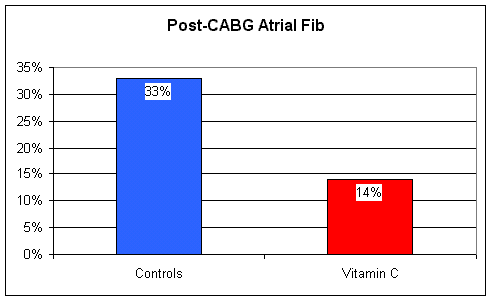 Chung's
group found that Vitamin C decreased the rate of post-bypass atrial fibrillation
by 57% (similar to the effect of Vitamin C on the need for repeat
angioplasty). A lot of people can be helped for just pennies a day.
Chung's
group found that Vitamin C decreased the rate of post-bypass atrial fibrillation
by 57% (similar to the effect of Vitamin C on the need for repeat
angioplasty). A lot of people can be helped for just pennies a day.
5. Usefulness of Antioxidant Vitamins in Suspected Acute Myocardial Infarction (The Indian Experiment of Infarct Survival-3). Singh, R, et al. American Journal of Cardiology 1996;77:232-36
As discussed in article 4, free radical inflammation occurs when heart cells are starved of oxygen and then suddenly resupplied with highly oxygenated blood. This phenomena occurs following bypass surgery and compromises patient outcome; Dr. Sisto showed us that a Vitamin C containing antioxidant cocktail could blunt this "reperfusion injury" and improve patient outcome following bypass surgery. Oxygen starvation followed by oxygen resupply occurs during a heart attack, when one of the arteries serving the heart suddenly closes off, and we know that this "reperfusion injury" generates additional heart muscle damage and sets the stage for cardiac rhythm disturbances. Singh and colleagues proposed that antioxidant supplementation, begun in the emergency room, would blunt reperfusion injury and improve patient outcome following heart attack.
In this study, 125 patients presenting with their first heart attack were randomly divided to receive either a 28 day antioxidant regimen consisting of: Vitamin C 1,000 mg and Vitamin A 50,000 IU/day, both given IV over 3 days and then taken orally, along with Vitamin E 400 IU and Beta carotene 25 mg/day, both taken orally, or a matching 28 day placebo regimen. The care the patients received was otherwise the same. The study was carried out in double-blind format; neither the patients nor the researchers knew who was taking the antioxidant cocktail or the matching placebo preparations. So what affect, if any, did the antioxidants have on post-heart attack outcome?
Dr. Singh recorded cardiac enzyme values and carried out serial EKGs on all 125 patients. When we say that a heart attack has been diagnosed because your "enzymes" are elevated, we are referring to proteins which are found exclusively within heart muscle cells. If the cells die, as occurs with a heart attack, these proteins are released into the circulation. The higher your enzyme values, the more cells died, the larger the heart attack, and the more likely you are to experience a complication of the heart attack. The change in your EKG also correlates with the size of the heart attack and the amount of heart muscle lost. Dr. Singh found that the enzyme levels were lower, and the EKG was less abnormal, in the patients assigned to antioxidant vitamin supplementation. The antioxidants neutralized the free radicals generated by the heart attack; thus the patients receiving antioxidant vitamins had smaller heart attacks.
Most of the things that can go wrong following a heart attack go wrong within 28 days; Dr. Singh followed his 125 heart attack patients over that time interval, and their 28 day outcome parameters are given below:
|
Parameter |
Antioxidant |
Control |
Risk Reduction |
|
Recurrent Angina |
15.8% |
27.4% |
42% |
|
Heart Failure |
6.3% |
11.3% |
44% |
|
Serious Arrhythmia |
11.1% |
20.9% |
47% |
|
Hypotension |
1.6% |
4.8% |
67% |
| 2nd Heart Attack | 11.1% | 16.1% | 31% |
| Cardiac Death | 9.5% | 14.5% | 35% |
| Cardiac Events | 20.6% | 30.6% | 33% |
We don't like it when our patients experience recurrent angina following a heart attack; this signifies that they are at risk for further damage; the antioxidant patients were 42% less likely to experience post-heart attack angina. The larger the heart attack, the more likely is the patient to go into heart failure and/or experience hypotension or an arrhythmia; the antioxidants were protective here as well. Total cardiac events, recurrent heart attack, and cardiac death rates were all blunted by about a third. A lot of misery was spared for $1 a day's worth of nutritional medicine.
A Vitamin C containing antioxidant cocktail improves outcome and decreases event rate following heart attack
6a. The Antioxidant Supplementation Atherosclerosis Prevention Study. Salonen, J, et all. European Heart Journal Abstract 1999, cited in Family Practice News. 1999 Oct 15;29(20):8.
Vitamin C, and for that matter all of the nutritional and pharmacologic agents that we use to benefit the heart patient, do not work primarily by opening up the artery, but instead by protecting the narrowed artery from plaque rupture, spasm, and clot formation. With Vitamin C we aren't attempting to carry out a chemical roto-rooter effect; rather we favorably affect blood flow rate and the functional integrity of the endothelial cells that line the artery. Vitamin C doesn't change anatomy; it changes physiology, and physiology is more important. Still, if a treatment delays the rate at which the narrowings progress, then that is a plus. We know that the statin class cholesterol lowering agents can favorably affect coronary artery anatomy and endothelial tone; can Vitamin C do the same?
Looking at the affect of a given treatment on the caliber of the coronary arteries is rather difficult. Serial angiograms are necessary, entailing significant cost and some risk to the subjects. Carrying out carotid ultrasound scans is relatively inexpensive, and involves no risk to the subjects. In this study, Dr. Salonen and colleagues measure the thickness of the carotid artery wall, the intima-media thickness, in 520 high-risk Finnish patients. He then assigned them to receive Vitamin C, 500 mg/day, Vitamin E, 272 IU/day, both, or a double placebo. The ultrasound scans were repeated 3 years later. Wall thickness increased in the double placebo group, on average by 20 micrometers/year. All the antioxidant regimens retarded the rate at which atherosclerotic wall thickness progressed, as depicted in the chart below:
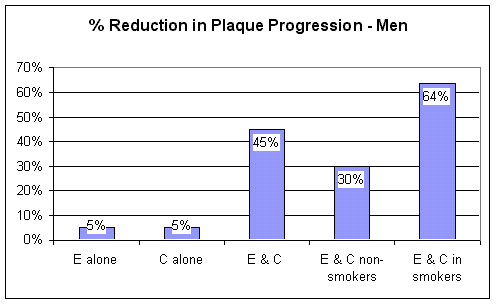 Monotherapy
with Vitamin E or Vitamin C alone had only a minimal effect. Our innate
antioxidant defense against free radical inflammation is really a team defense,
so we are not surprised to see synergy when E and C are taken together; in these
patients disease progression was blunted by 45%. Dr. Salonen points out
that one of Vitamin C's functions is to regenerate spent Vitamin E. In
other words, without Vitamin C, Vitamin E supplementation won't be as effective. Think of what Dr. Salonen
might have found if he had given his subjects a cocktail of antioxidant vitamins
and minerals (such as we recommend to our patients).
Monotherapy
with Vitamin E or Vitamin C alone had only a minimal effect. Our innate
antioxidant defense against free radical inflammation is really a team defense,
so we are not surprised to see synergy when E and C are taken together; in these
patients disease progression was blunted by 45%. Dr. Salonen points out
that one of Vitamin C's functions is to regenerate spent Vitamin E. In
other words, without Vitamin C, Vitamin E supplementation won't be as effective. Think of what Dr. Salonen
might have found if he had given his subjects a cocktail of antioxidant vitamins
and minerals (such as we recommend to our patients).
The treatment effect was greater in smokers than in non-smokers. This makes sense. Cigarette smoke destroys Vitamin C, one of the means by which smoking promotes cardiovascular disease. Smokers thus have a greater relative need for Vitamin C, and consequently a more robust treatment benefit.
6b. Serial Coronary Angiographic Evidence That Antioxidant Vitamin Intake Reduces Progression of Coronary Artery Atherosclerosis. Hodis, H, et al. Journal of the American Medical Association 1995;273:1849-54
In the CLAS, or Cholesterol Lowering Atherosclerosis Study, baseline and 2-year coronary angiograms were carried out in 156 men who had previously undergone bypass surgery (the native arteries were looked at, not the grafts). The diameter of the coronary arteries was measured at the first angiogram. The men were then randomized to receive advice on a low cholesterol diet, or to receive dietary advice and cholesterol lowering drug therapy. The advice and drug therapy group achieved an average LDL cholesterol of 100 mg/dl at the 2-year point; the advice only group maintained an LDL value of 150. The angiograms were then repeated. Less disease progression was seen in the LDL 100 group. This paper was published in '95, and from that point on an LDL of 100 became our treatment goal in individuals with known coronary disease.
Now, some of the subjects in both groups took antioxidants. The use of antioxidants was at the discretion of the subjects; here the subjects were not randomized. The charts below describe disease progression, as the relative change in the percent narrowing of the vessels measured:
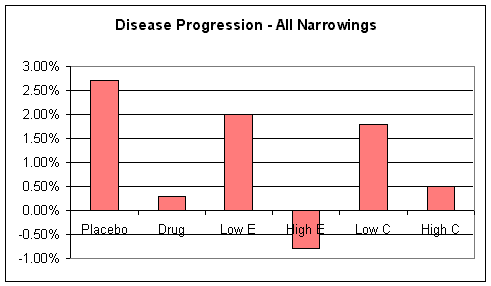 The first chart looks at all narrowings; disease
progression was obviously blunted by drug treatment, which led to an end-study LDL of
100. You can also see (charts below) that high Vitamin E intake
(>100 IU/day) or high C intake (>250 mg/day) had a favorable effect on
disease progression. Vitamin supplementation synergized with LDL
reduction, and this makes sense. It's not the LDL cholesterol that hurts
us, its the oxidized LDL that layers out in our arteries. The less LDL there is
floating around, then the less LDL there is to be oxidized by free
radicals. The more antioxidants floating around, the better can we protect
our LDL from free radical mediated oxidation. The charts below show us
that the combination of an LDL of 100 and the intake of antioxidants E and C led
to disease regression. A chemical roto-rooter effect did occur; the
diseased arteries opened up a little, certainly a plus.
The first chart looks at all narrowings; disease
progression was obviously blunted by drug treatment, which led to an end-study LDL of
100. You can also see (charts below) that high Vitamin E intake
(>100 IU/day) or high C intake (>250 mg/day) had a favorable effect on
disease progression. Vitamin supplementation synergized with LDL
reduction, and this makes sense. It's not the LDL cholesterol that hurts
us, its the oxidized LDL that layers out in our arteries. The less LDL there is
floating around, then the less LDL there is to be oxidized by free
radicals. The more antioxidants floating around, the better can we protect
our LDL from free radical mediated oxidation. The charts below show us
that the combination of an LDL of 100 and the intake of antioxidants E and C led
to disease regression. A chemical roto-rooter effect did occur; the
diseased arteries opened up a little, certainly a plus.
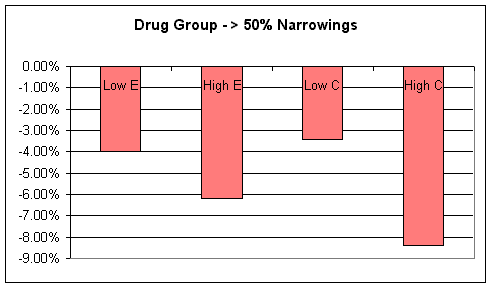
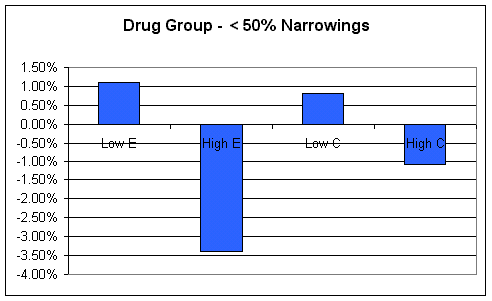
Vitamin C retards coronary disease progression and with LDL reduction leads to disease regression
6c. Serial Arteriography in Atherosclerosis. Willis, G, et al. Canada Medical Assoc. Journal. Dec. 1954. Vol. 71, pages 562-72.
It would be nice if I was on the cutting edge of Vitamin C in cardiovascular medicine, but I can assure you that I am not. In 1940 Patterson, a pathologist, demonstrated that heart attacks were not due to the build-up of atherosclerotic plaque material within the wall of an artery serving the heart, but rather to destabilization or rupture of the fibrous cap that covers the plaque. A second report from Patterson, published in 1941, linked this plaque destabilization to Vitamin C deficiency. Working with conscious objectors in 1944, Sir Hans Krebs found that he could bring out not just scurvy, but chest pain and EKG findings of coronary insufficiency (both Vitamin C responsive), when previously healthy young people were placed on an ultralow Vitamin C ration. Trimmer and Lundy, in 1947, noted low blood Vitamin C levels in their patients with coronary artery disease. In the early 50's, Willis demonstrated below normal arterial Vitamin C content in individuals dieing of cardiovascular disease. Willis placed guinea pigs (like man, guinea pigs cannot manufacture Vitamin C) on a low Vitamin C diet. The guinea pigs all developed vascular disease, which could be reversed when Vitamin C was resupplied to their diet. Dr. Willis concluded that Vitamin C deficiency was a critical factor in atherosclerosis, and he put his reasoning to good use in humans in a 1954 report, which is abstracted below.
Dr. Willis had observed at autopsy, that all
patients with significant coronary disease and prior heart attack also had
evidence of atherosclerotic plaque buildup in their femoral and popliteal
arteries (the arteries to the legs, between the groin and back of the
knee). He thus felt that vascular changes in the femoral-popliteal region,
which he could visualize with angiography, would reflect what was going on in
the coronary arteries (in '54 coronary angiography was not being done in
Montreal, where Willis practiced). Based on the work cited above, Dr.
Willis felt that Vitamin C deficiency played a role in atherosclerosis, and he
reasoned that C supplementation would modify its course. To test out his
hypothesis, Dr. Willis and his associates carried out femoral-popliteal
angiographic studies in 22 middle-aged men with symptomatic cardiovascular
disease or diabetes. 16 of the men were then placed on Vitamin C at a dose
of 500 mg three times a day; the other 6 subjects, matched with the treatment
group for baseline disease severity, received no Vitamin C. Dietary advice
was given to the diabetics, but otherwise no other preventive measures were
carried out (I wasn't around to tell Willis to co-treat his subjects with
Vitamin E as I hadn't been born yet). The angiograms were repeated 2 to 6
months later and compared against the baseline studies; the cardiologist reading
the films did not know which subjects had or had not received Vitamin C.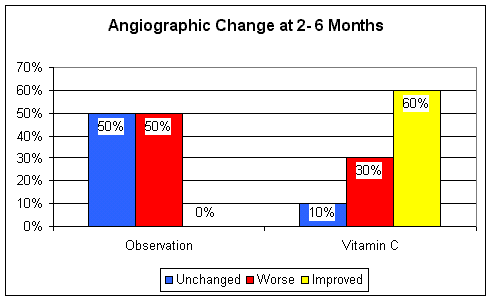 Two of the original 6 control subjects were placed on Vitamin C after their
follow-up angiogram, and a third angiogram was then carried out 3-4 months
later.
Two of the original 6 control subjects were placed on Vitamin C after their
follow-up angiogram, and a third angiogram was then carried out 3-4 months
later.
In the 6 control patients, plaque size and symptomatic statues was unchanged in 4. In the other 2, disease progression was noted, accompanied by a worsening of symptoms; these 2 patients were then begun on Vitamin C.
In the Vitamin C group, the narrowings worsened in 3 subjects; 1 died of pneumonia and in 2 symptoms were unchanged. In 1 subject, no change in angiographic appearance or symptoms was noted. In the remaining 6 subjects, including the 2 initial control patients who were later switched to Vitamin C after they worsened off C, the vascular plaques decreased in size - angiographic disease regression had occurred. Symptoms were unchanged in 3 of these 6 angiographic improvers, while in the other 3 symptoms lessened, not something they saw a lot of in '54.
This brings us back to our lead paper, Dr. Nicolaides' 10 year study showing that Vitamin C supplementation decreases disease progression, event rate, and mortality. In 1954 Dr. Willis showed that Vitamin C decreased event rate and lessened symptoms in patients with advanced cardiovascular disease. The principles of medical science don't change much when they are correct.
Vitamin C worked in 1954 and it still works in 2003
7. Ascorbic Acid Treatment Lowers Blood Pressure in Patients with Hypertension: A Randomized, Placebo-Controlled Study. Duffy, A, et al. Circulation Abstracts from the 72nd Scientific Sessions, Abstract 4257, page 1-807.
Maintenance of the relaxed, dilated status of our arteries is the job of Nitric oxide, an angiochemical that is manufactured by the endothelial cells that line our arteries; our arteries thus make the substance which keeps them in their relaxed, functional state. When Nitric Oxide levels are low, our arteries will constrict, and when the arteries constrict, then blood pressure will rise. All hypertensive individuals can be said to have an arterial Nitric Oxide deficit.
Our cells manufacture Nitric Oxide from arginine (and arginine supplementation will help with BP control). The Nitric Oxide so generated can be put to good use, dilating our arteries and keeping our BP low, but not if it is quickly destroyed by Superoxide, a free radical angiochemical. In health, there is a balance between Nitric Oxide and Superoxide generation. We need some Superoxide, to prevent Nitric Oxide from lowering our BP too much, but Superoxide excess, as occurs in individuals with vascular disease and in all individuals with hypertension, leads to Nitric Oxide deficiency; our vessels will constrict and our BP will rise. High BP itself generates more Superoxide, more Nitric oxide will be lost, the BP rises higher...a vicious cycle develops. This is why, when we treat your hypertension with drugs only, we often have to keep increasing the dose or add in new drugs - drugs themselves are not dealing with the underlying biochemical flaw (Angiotensin Converting Enzyme Inhibitor drugs do address this flaw and are effective as drugs go).
Now, Vitamin C can neutralize Superoxide. If enough Vitamin C is available to neutralize Superoxide, Nitric Oxide will be spared and can do what it is supposed to do, dilate our arteries. An understanding of this biochemistry prompted Dr. Duffy to study the use of Vitamin C as an anti-hypertensive agent.
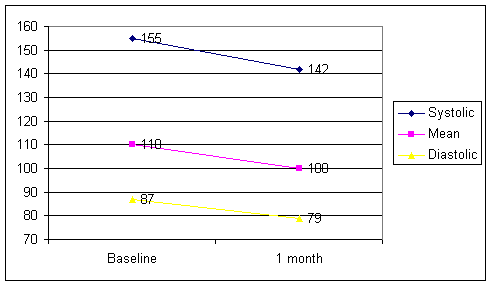 39 hypertensive subjects were randomly assigned to receive, over 4 weeks,
Vitamin C 500 mg/day, or a placebo. A double-blind protocol was followed;
neither the subjects or investigators knew who was taking Vitamin C or who was
taking the placebo.
39 hypertensive subjects were randomly assigned to receive, over 4 weeks,
Vitamin C 500 mg/day, or a placebo. A double-blind protocol was followed;
neither the subjects or investigators knew who was taking Vitamin C or who was
taking the placebo.
Diastolic BP fell slightly in the placebo group, but the systolic and mean BP values did not change (not shown). The graphic to the left shows what happened with Vitamin C supplementation. The 8 mmHg drop in diastolic BP was not statistically significant, while the 13 and 10 mmHg decreases in systolic and mean BP values were. This is not a dynamite drop in BP, but the values are certainly going in the right direction. Vitamin C (preferably taken with other antioxidants and minerals) may be enough to control early or mild hypertension. Vitamin C alone will not be enough to control severe or long-standing hypertension, but it still makes sense to address the underlying physiologic flaw with Vitamin C, as we prescribe BP lowering pharmaceutical agents. (Magnesium, Arginine, Co-Enzyme Q, and Calcium also help with BP control, but that is another story). In the treatment of hypertension, Vitamin C is working primarily as an antioxidant, improving endothelial function, but C also helps by removing lead. Lead plays a role in hypertension; the effects of Vitamin C on lead levels is examined in another section.
Vitamin C helps with BP control
8. Lipoprotein(a): The Ugly Cholesterol
Several of the articles abstracted above refer to Lipoprotein (a), a key cause of atherosclerosis, and a cause of atherosclerosis that most patients and many physicians are not aware of. I am well aware of Lp(a), because most of the people who see us for EECP have Lp(a) levels off the chart. Lp(a) promotes restenosis after angioplasty and graft failure after bypass surgery. Problems recur, further invasive treatments are not felt to be possible, and these patients are then referred to us for EECP. We treat these patients with EECP, and for sure we address the Lp(a) elevation that made them sick in the first place. The drug companies have made us aware of the importance of lowering our LDL cholesterol values. Unfortunately, there are no prescription drugs with significant activity against Lp(a), so we aren't going to see adds during the Super Bowl talking about how bad Lp(a) is and how great Vitamin C is. The essay below serves as a primer on Lipoprotein(a) and presents the position of two time Nobel Prize winner Dr. Linus Pauling, who considers atherosclerosis to be a disease primarily of Vitamin C deficiency and Lipoprotein(a) excess (we know that other factors play a role, but Dr. Pauling's theory fits well with all the other science that we have). Lp(a) is covered in great detail in our Lecture: The Ugly Cholesterol - Lipoprotein (a) and Vitamin C, which will be given in the spring.
LIPOPROTEIN(a):
THE UGLY CHOLESTEROL
Lipoprotein(a), abbreviated as Lp(a), is
composed of one molecule of LDL, the bad cholesterol, chemically bound to a
carrier protein called apolipoprotein(a). Lp(a)
is an adhesive particle, and in health serves to repair and restore the
structural integrity of a damaged blood vessel wall -a
sort of biological super glue. It’s
apolipoprotein(a) component promotes blood clotting and inhibits your body’s
blood clot dissolving system. This
is Mother Nature’s mechanism to prevent excessive blood loss from a damaged
vessel. Lp(a) also promotes vessel
wall cellular growth and proliferation, and its LDL cholesterol is incorporated
into the regenerating cells. Essentially,
Lipoprotein(a) is a repair molecule, an “artery patch”.
Vitamin C can also serve to maintain or restore
the wall strength of our blood vessels, rendering Lp(a) unnecessary,
A dog the size of an average man will convert dietary sugar (glucose)
into 20,000 mgs. of Vitamin C each day. We
will see that this is nature’s preferred approach.
Man, the great apes, guinea pigs, and hedgehogs lost the ability to make
Vitamin C from sugar, and rely on Lp(a) instead to keep their arteries intact.
Man and these other species do develop coronary artery disease.
All other animals make Vitamin C; Lp(a) is not found in their blood, and these
animals never develop coronary disease. These
Vitamin C producers do not obstruct their blood vessels with
cholesterol and blood clots!
During the Ice Age, agriculture ground to a halt and
natural fruits and vegetables were in short supply.
Animals that could manufacture their own Vitamin C could handle this, but
mankind began to die off from blood loss anemia.
Without Vitamin C, we developed chronic scurvy; blood leaked out from our
damaged arteries and we had no way to repair our vessels or to stop the
bleeding. Evolution than provided
mankind with a solution. A genetic
mutation of plasminogen, the circulating protein that promotes blood clot
dissolution, created apolipoprotein(a), a plasminogen look alike that does just
the opposite, promoting blood clot formation and antagonizing plasminogen
mediated clot dissolving. Apo(a)
plugged the hole in the dike. Combined
with LDL to form Lp(a), it restored the strength of our vessels.
Individuals who couldn’t make Lp(a) died; those who could make Lp(a)
survived the Ice Age and passed on their
Lp(a) producing genes to their descendants.
This is why some Lp(a) is present in all of us.
Lp(a) obviously saved mankind from extinction during the Ice Age, but
what is this cholesterol/clot producing patch system doing to us now?
2.
The role of Lp(a) in vascular disease.
After the Ice Age, dietary Vitamin C became
plentiful again, our vessels were strong, and Lp(a) vascular “repair” was
not needed. Our Vitamin C intake was at “animal” levels and mankind did not
experience coronary disease. With
the advent of modern day food processing, we are again becoming Vitamin C
deficient, and in our current “diet induced Ice Age”, we are again calling
upon Lp(a) to patch up and repair our arteries, and today we call that patching
system ATHEROSCLEROSIS.
Lp(a) levels are under hereditary control; if your level is high, that
is because your ancestors needed more to get them through the Ice Age.
The higher your level, the greater is your risk.
Lp(a) binds to lysine and proline within the wall of a damaged or
weakened artery, depositing its LDL and promoting the deposition of circulating,
oxidized LDL into the artery’s
wall, narrowing the artery. Lp(a)
promotes the formation of blood clots on top of the cholesterol plaque, abruptly
narrowing the artery further, bringing on or worsening your symptoms. If the
clot is large enough, it will occlude the artery, producing a heart attack.
We now know that most heart attacks are due to a large blood clot
developing in vessels with moderate narrowings (therefore you are still at risk
with a 50% narrowing).
Lp(a) levels typically range from 1 to 100; the highest level so far in
our practice has been 200. Mg. for
mg, Lp(a) has 10 times the plaque producing potential of LDL.
The average American value is 14: 13 in healthy individuals and 19 in
coronary patients. Lp(a) selectively
accumulates in your arteries; a level above 30 doubles your risk, and if your
LDL is also elevated, your risk rises by a factor of 5.
Lp(a) also concentrates in the walls of your bypass grafts; 90% of
individuals whose bypass grafts clog up have Lp(a) levels above 31.
Balloon angioplasty (PTCA) is basically a
controlled trauma to the vascular wall, and Lp(a), always a “repair”
molecule, will concentrate at the site of balloon dilation, promoting clot
formation and cholesterol deposition. You
certainly won’t be surprised to learn that Lp(a) has been implicated as a
cause of restenosis, renarrowing of the blood vessel following angioplasty. In
one study, the Lp(a) level averaged 7 in patients who did not renarrow, and 19
in those who did. Those patients
with a level above 40 were 11 times more likely to restenose than those with
levels below 4. Those with levels
above 19 were 6 times as likely to renarrow.
3.
What can I do to lower my Lp(a) related coronary risk?
Plenty:
A. Have
your Lp(a) level measured (along with your other risk factors).
B.
If
your level is elevated, work with your doctor to lower it with Niacin
C. The
Lp(a) that cannot be lowered can be neutralized by supplemental Lysine and Proline.
By occupying the binding sites on the circulating
Lp(a) particle, Lysine and Proline prevent
Lp(a) from attaching to Lysine and Proline within the
vascular wall, and if the Lp(a) cannot attach, it cannot promote
cholesterol deposition and blood clotting within the coronary artery.
In optimal doses, Lysine and Proline may be able to insinuate themselves
between bound Lp(a) and the vascular wall, freeing up
Lp(a) and
pulling it out of the vascular wall. The now freed-up
Lp(a) will take
cholesterol out with it, lessening the degree of
vessel narrowing.
D. To
learn more, please attend our next “The
Ugly Cholesterol - Lipoprotein (a) and Vitamin C” talk.
Eradicating
Heart Disease and Why Animals
Don’t Get Heart Attacks, by Mathias
9. Serum Vitamin C Concentration Is Low in Peripheral Arterial Disease and Is Associated With Inflammation and Severity of Atherosclerosis. Langlois, M, et al. Circulation 2001;103:1863-68.
C-Reactive Protein, referred to as CRP, is a bad guy, just as much a problem to you as Lipoprotein(a). Inflammation, associated with plaque rupture, vasospasm, and clot formation, is the force that destabilizes the arterial narrowing. Inflammation puts the "vulnerable" in the "vulnerable plaque", and your CRP level reflects the level of inflammation in your circulation. CRP, irrespective of cholesterol, is a potent, continuous risk factor for cardiovascular disease. In other words, the higher your CRP, the more likely are you to develop a blocked artery, whether or not your cholesterol or BP are elevated. In patients with established cardiovascular disease, an elevated CRP is associated with more rapid disease progression, and a worse outcome following heart attack or angioplasty. Just as with Lp(a), an elevated CRP increases the risk of post-angioplasty restenosis. CRP is a bad guy, and we spend a lot of time and attention on CRP reduction in our patients. We know that Vitamin C levels tend to be low, and CRP levels high, in patients with cardiovascular disease. Dr. Langlois, in the study abstracted below, set out to further understand and explain this relationship:
Langlois and his colleagues measured Vitamin C and CRP levels in 85 patients with symptomatic lower extremity vascular disease (their leg muscles cramped up while walking, due to insufficient blood flow), 106 asymptomatic hypertensive subjects, and in 113 healthy volunteers. Vitamin C levels were correlated with disease severity in the 85 vascular patients. The effect of smoking on the Vitamin C and CRP levels was also looked at. His findings as shown below:
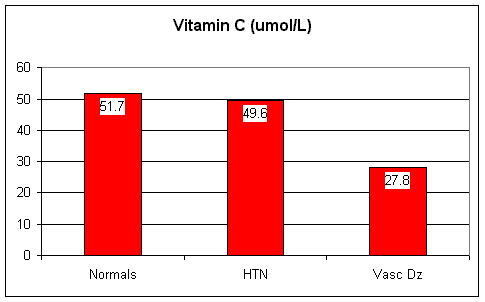
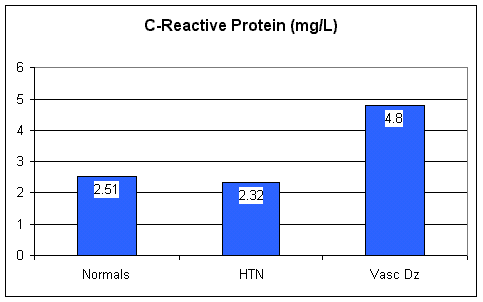
The average Vitamin C level in normal subjects
and asymptomatic hypertensives hypertensives is about the same, but its nearly 50% lower in
patients
with vascular disease. 52% of the vascular patients had Vitamin C levels
below 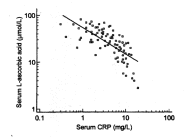 normal (<28.4 umol/L), and 14% had severe Vitamin C deficiency
(<11.4 umol/L). The CRP levels are about the same in the normal volunteer
and hypertensive subjects, but they are nearly twice as high in the vascular
disease patients. The graph on the left demonstrates an
inverse relationship between Vitamin C (Ascorbic Acid) and CRP in the 85 vascular
patients. The charts below demonstrate the inverse relationship that
exists between CRP levels and disease severity in this group,
and the similar relationship between Vitamin C deficiency and disease activity.
normal (<28.4 umol/L), and 14% had severe Vitamin C deficiency
(<11.4 umol/L). The CRP levels are about the same in the normal volunteer
and hypertensive subjects, but they are nearly twice as high in the vascular
disease patients. The graph on the left demonstrates an
inverse relationship between Vitamin C (Ascorbic Acid) and CRP in the 85 vascular
patients. The charts below demonstrate the inverse relationship that
exists between CRP levels and disease severity in this group,
and the similar relationship between Vitamin C deficiency and disease activity.
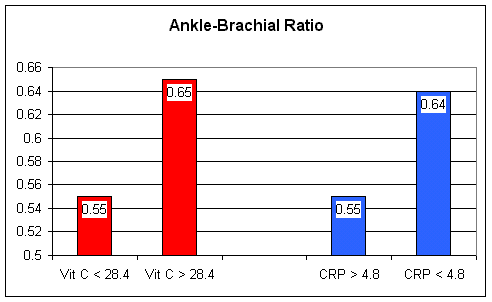
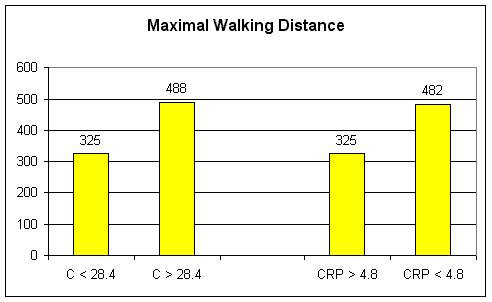
Ankle-Brachial Ratio (ABR) reflects the degree of impairment in lower extremity blood flow, while Maximal Walking Distance reflects the functional impairment experienced by the patient. To calculate the Ankle-Brachial Ratio, we measure BP in the arm, and again at the level of the ankle. If all the pipes are open, then the ratio should be 1.0. Allowing for measurement error, a ratio of 0.9 or above is considered normal, while a ratio of 0.5 or below indicates limb-threatening, severe disease. As vascular disease worsens, the ABR will fall. Conversely, we want to see an improvement in ABR as a result of the treatments that we recommend. You can see from the charts that the ABRs were lower, reflecting more severe disease, in the patients with lower Vitamin C and higher CRP levels. Maximal Walking Distance reflects how far the patient can walk before having to stop due to claudication (muscle pain brought on by insufficient blood flow to the leg muscles - "angina of the legs"). Here again, low Vitamin C and high CRP patients had much more trouble.
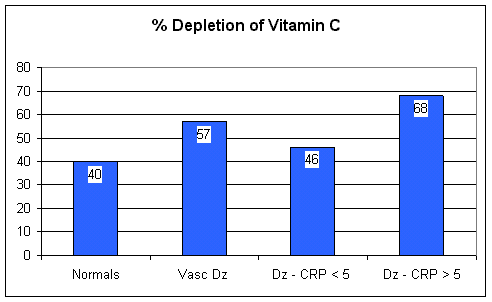 Langlois
then asked: Why are the Vitamin C levels low in the high CRP
patients? There was no difference in dietary Vitamin C intake between the
high C and low C blood level groups, and none of the patients were taking vitamin
supplements. Langlois hypothesized that there was something about the high
CRP patients that "burned up" Vitamin C. To test this
hypothesis, Langlois took serum samples from non-smoking vascular patients and
non-smoking normal volunteers, and added to each sample a defined amount of
Vitamin C. He then let the test tubes sit, and four hours later
measured how much Vitamin C was left in each sample. The chart of
the left, % Depletion of Vitamin C, reflects how rapidly the added Vitamin C was
metabolized, or "burned up". In the normal volunteers, 40% of
the added Vitamin C was used up at 4 hours, while the serum of the vascular patients used up
57%. Amongst the vascular patients, those with high CRP levels burned up
even more. This makes sense: CRP reflects inflammation and
oxidation; these processes generate free radicals, which in turn "burn
up" Vitamin C. With low Vitamin C levels, the patient cannot cope
with or stabilize the inflammatory, atherosclerotic process that is trying to
close off their vessels; the vessels continue to narrow with more plaque, the
inflammatory process heats up further, more free radicals are generated, and
more Vitamin C is consumed - basically there exists in the cardiovascular
patient a vicious cycle between Vitamin
C depletion and vascular inflammation, leading to the decline and eventual death
of the patient, punctuated by recurrent adverse events (unless, of course, we do
something to address this process).
Langlois
then asked: Why are the Vitamin C levels low in the high CRP
patients? There was no difference in dietary Vitamin C intake between the
high C and low C blood level groups, and none of the patients were taking vitamin
supplements. Langlois hypothesized that there was something about the high
CRP patients that "burned up" Vitamin C. To test this
hypothesis, Langlois took serum samples from non-smoking vascular patients and
non-smoking normal volunteers, and added to each sample a defined amount of
Vitamin C. He then let the test tubes sit, and four hours later
measured how much Vitamin C was left in each sample. The chart of
the left, % Depletion of Vitamin C, reflects how rapidly the added Vitamin C was
metabolized, or "burned up". In the normal volunteers, 40% of
the added Vitamin C was used up at 4 hours, while the serum of the vascular patients used up
57%. Amongst the vascular patients, those with high CRP levels burned up
even more. This makes sense: CRP reflects inflammation and
oxidation; these processes generate free radicals, which in turn "burn
up" Vitamin C. With low Vitamin C levels, the patient cannot cope
with or stabilize the inflammatory, atherosclerotic process that is trying to
close off their vessels; the vessels continue to narrow with more plaque, the
inflammatory process heats up further, more free radicals are generated, and
more Vitamin C is consumed - basically there exists in the cardiovascular
patient a vicious cycle between Vitamin
C depletion and vascular inflammation, leading to the decline and eventual death
of the patient, punctuated by recurrent adverse events (unless, of course, we do
something to address this process).
As smoking produces free radical stress and inflammation, Langlois reasoned that smokers would have lower Vitamin C and higher CRP levels. As aspirin has an anti-inflammatory effect, he felt that patients on aspirin might have lower CRP and better preserved Vitamin C levels. The charts below show that Langlois was right on both counts:


Smoking produces free radicals and wastes Vitamin C. This is why Vitamin C levels tend to be low in smokers, and is one of the reasons underlying the causative link between smoking, cardiovascular disease, and cancer. This explains why, in Dr. Salonen's study of the effect of vitamin supplementation on carotid artery disease progression (article 6), Vitamin C had a greater affect in smokers than in non-smokers. Smoking had no major affect on the CRP level, which is related more to inflammatory processes within the circulation. Aspirin use spared Vitamin C. Aspirin blunts inflammation, thus less free radicals are generated, thus Vitamin C is less "burned up". Aspirin blunts inflammation and inflammation drives up the CRP; thus it makes sense that aspirin users would have lower CRP values, as Langlois found. Langlois' findings are summarized below:
Vitamin C deficiency and an elevated CRP are key driving forces underlying atherosclerotic vascular disease. They typically co-exist in the vascular patient, where the lower the Vitamin C level and the higher the CRP, the worse will be the patient's disease burden and level of symptoms. Smoking wastes Vitamin C, while aspirin spares Vitamin C and helps keep CRP under control.
Vitamin C deficiency and an elevated CRP drive the atherosclerotic process forward
10a. Vitamin C and Plasma Cholesterol. Harri Hemila Critical Reviews in Food Science & Nutrition 32(1):33-57 '92.
In cardiology, Vitamin C is used as an anti-inflammatory anti-oxidant that improves endothelial function, not as a lipid lowering agent, but Vitamin C does have a cholesterol lowering effect and it makes sense for us to examine it.
Hundreds of epidemiologic studies have examined the relationship between Vitamin C and cholesterol. As a rule, high Vitamin C intake, high blood levels, and high cellular levels have been associated with lower total cholesterol, LDL cholesterol, and triglyceride values, and with higher HDL levels. This rule holds not just for individuals, but for whole societies. Individuals and societies with low Vitamin C status have, in turn, higher LDL and lower HDL values.
Where things get a little confusing is when Vitamin C supplementation is used as a treatment for high cholesterol. Some studies show a benefit, while some don't. When we carry out studies of cholesterol-lowering drugs, the cholesterol falls in every patient treated, even if their cholesterol level was normal to begin with; the only question is how far the level will fall. So why does Vitamin C lower cholesterol in some but not all people?
Dr. Hemilia reviewed hundreds of Vitamin C supplementation studies, and came up with a common sense, but still scientifically sound answer: Your body is smart and uses Vitamin C to lower cholesterol only when it is needed, when the cholesterol levels are significantly elevated to begin with. Dr. Hemilia looked at 8 studies where subjects with cholesterol levels below 190 mg/dl received 1-2000 mg/day of Vitamin C: the average cholesterol level rose by 6%. In 23 studies, Vitamin C was administered to subjects with pre-treatment cholesterol levels above 250; here the average cholesterol level fell by 12%. In subjects with intermediate cholesterol values, between 190 and 250, guess what: the cholesterol values fell by 5%.
21 studies looked at the effect of Vitamin C on HDL levels: in 6 the HDL level actually decreased, in 3 there was no change, while in 12 the HDL rose, between 2 and 31%. Triglycerides levels fell in 21 of 27 studies reviewed, between 3 and 51%, where unchanged in 3, and rose in 3, between 7 and 20%. How does Vitamin C work here?
Most of the cholesterol in our body is manufactured in the liver; the rest is obtained from ingested foodstuffs. Mother Nature's plan is for the cholesterol entering our circulation to be taken up by our cells and be put to good use (to make hormones and new cell membranes). Excess cholesterol returns to the liver and is metabolized. When this process goes out of balance, when cholesterol input into the circulation outpaces cholesterol removal by the liver, then the cholesterol left over can be oxidized and layered out in our vessels as atherosclerotic plaque. So how does the liver metabolize, or clear, excess cholesterol from the circulation?
Bile acids are manufactured in the liver, stored in the gall bladder, and then injected into the small intestine following a meal. Bile acids are digestive enzymes; their job is to help you breakdown and then absorb ingested fats. The bile acids then leave the body in the stool, and the liver then manufactures more. The liver manufactures bile acids from, you guessed it, cholesterol, and Vitamin C is needed to convert cholesterol into bile acids. Without Vitamin C, the liver cannot convert cholesterol into bile acids, fat digestion is impaired, but of greater importance, excess cholesterol cannot be removed from the circulation - uh Oh. So, if your cholesterol is elevated, you need more Vitamin C to metabolize it than would an individual with a lower cholesterol level. Thus your cholesterol will likely fall with Vitamin C supplementation, while if your cholesterol is normal to begin with, then Vitamin C will have no effect. Vitamin C, and in general all nutritional treatments, work only when your body needs them; they are simply helping the body do something that it is designed to do, here converting excess cholesterol into bile acids. So take your Vitamin C and give your liver a fair chance to do what it is supposed to do.
Vitamin C assists in the conversion of cholesterol into bile acids
10b. Lipoprotein(a) Reduction by Ascorbate. Mathias Rath MD Journal of Orthomolecular Medicine Vol. 7, No. 2, 1992, pp. 81-82.
While Vitamin C has modest value as a general cholesterol control agent, Vitamin C is a critical component in our
approach to Lipoprotein(a) - see Section 8 Lipoprotein(a) - Archrival and nemesis of Vitamin C. We use Vitamin C primarily to antagonize the plaque and clot forming tendency of Lp(a), but Vitamin C does have some effect on the actual Lp(a) level. In this paper, Dr. Mathias Rath, who along with two time Nobel Prize winner Dr. Linus Pauling, brought the importance of Lipoprotein(a) to our attention, studied the effects of Vitamin C supplementation on Lp(a) levels in 11 coronary patients. Lp(a) levels were obtained at baseline and after 14 weeks of Vitamin C taken at 9000 mg/day.
| Patient | Baseline | Vitamin C | % Change | Patient | Baseline | Vitamin C | % Change |
| 1 | 87 | 43 | -51% | 7 | 29 | 27 | -7% |
| 2 | 92 | 59 | -36% | 8 | 60 | 44 | -26% |
| 3 | 104 | 76 | -27% | 9 | 69 | 48 | -30% |
| 4 | 36 | 27 | -27% | 10 | 48 | 56 | +16% |
| 5 | 93 | 40 | -43% | 11 | 110 | 126 | +14% |
| 6 | 27 | 18 | -33% | Average | 69 | 51 | -27% |
For the group, Lp(a) fell by 27%, and Vitamin C levels rose from 49 to 94 uM. Dr. Rath used a sensitive and specific measure of Lp(a) (sandwich ELISA method with monoclonal capture antibodies against apo(a), and pointed out the difficulty that the lab has in accurately measuring Lp(a) levels. It has been my personal experience that different labs will give us quite different Lp(a) levels, and I keep this in mind when interpreting the values in my own patients. We also feel that Vitamin C synergizes with Niacin in Lp(a) control; the combination forms NADPH, which is felt by Dr. Rath to inhibit Lp(a) formation in the liver.
Vitamin C lowers Lipoprotein(a)
11. Vitamin C gets the lead out - Article misplaced and I will track down the citation
Lead overload is an important health problem in the United States. Lead is not a trace mineral. Lead serves no role in our physiology and can be considered a "pure toxin". Unfortunately for us, lead is relatively plentiful in our modern environment. Even more unfortunate for us, our body doesn't know what to do with it. We weren't designed by Mother Nature or Evolution to deal with lead; we weren't even exposed to lead until the Industrial Revolution 250 years ago. To our physiology, lead is "pure trash", but trash that we don't know how to take out, so we store it in our cells. Intracellular storage space, of course, is in short supply, so the free lead then displaced useful metals, such as selenium, manganese, and zinc, from their binding sites on enzymes and other intracellular proteins, rendering them useless.
Lead is bad stuff. Hair lead levels correlate with lower IQs and the presence of learning disabilities in kids. Bone lead levels correlate with the presence of hypertension in adults. A "healthy" American adult has over 100 times as much lead in his bones as did a "healthy" man in 1oo years ago. Lead gums up our physiology and leads to free radical stress. Lead is an oxidizing agent, generating free radicals that damage cellular structures, such as mitochondrial enzymes (leading to fatigue), the LDL cholesterol particle (leading to heart disease), and our DNA (leading to cancer). Lead removal, on the other hand, has been shown to decrease cancer risk in animals and in humans. In a population living adjacent to a highway in Switzerland (when gasoline was still "leaded"), individuals who underwent a lead removal protocol (to address symptoms felt to be lead-related) were 1/10th as likely as their non-treated neighbors to develop a malignancy over the ensuing 12 years. This was not a randomized, double-blind, placebo controlled study, but the implication here is obvious and the message important: Get The Lead Out!
There are several means available to remove lead
from the body and I have been trained in these techniques. I tested myself
and was quite distressed to find that my lead (and mercury) levels were on the
high side. Where did the lead come from? I have lived in several old
houses, with lead pipes, and I run a lot, inhaling the wonderful
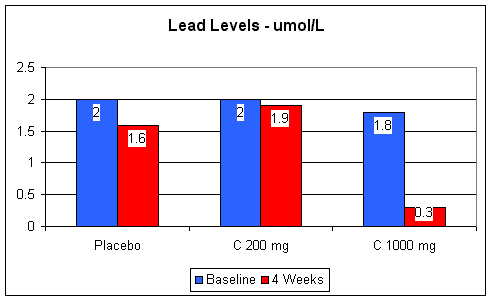 exhaust
vapors from cars and industry - these are the likely sources. I got
"deleaded"; my thinking now seems to be more creative and running is
certainly easier. So, how can we minimize our lead burdens? How can
we prevent lead overload in the first place? We can take prudent measures,
but we city dwellers can't totally avoid lead exposure, but we
can take Vitamin C. Individuals with high lead levels tend to have low
Vitamin C levels, and visa versa. Does this mean that Vitamin C detoxifies
lead, or that lead wastes Vitamin C? Actually its both. Old studies,
carried out in the 30s, described the use of Vitamin C as a lead
detoxifier. This notion was resurrected in the following study. Here
75 male smokers were randomized to receive
placebo, Vitamin C at 200 mg/day, or C at 1000 mg/day. Blood lead levels
were obtained at baseline and after 4 weeks of treatment. Low dose C
didn't have much effect, but look what happened to the 1000 mg group - their
lead levels plummeted. Now, blood lead levels don't necessarily reflect
your long-term, intracellular burden, but before lead can get into your cells,
it has to go through the blood, but its not going to get into the blood if you
take Vitamin C 1000 mg/day.
exhaust
vapors from cars and industry - these are the likely sources. I got
"deleaded"; my thinking now seems to be more creative and running is
certainly easier. So, how can we minimize our lead burdens? How can
we prevent lead overload in the first place? We can take prudent measures,
but we city dwellers can't totally avoid lead exposure, but we
can take Vitamin C. Individuals with high lead levels tend to have low
Vitamin C levels, and visa versa. Does this mean that Vitamin C detoxifies
lead, or that lead wastes Vitamin C? Actually its both. Old studies,
carried out in the 30s, described the use of Vitamin C as a lead
detoxifier. This notion was resurrected in the following study. Here
75 male smokers were randomized to receive
placebo, Vitamin C at 200 mg/day, or C at 1000 mg/day. Blood lead levels
were obtained at baseline and after 4 weeks of treatment. Low dose C
didn't have much effect, but look what happened to the 1000 mg group - their
lead levels plummeted. Now, blood lead levels don't necessarily reflect
your long-term, intracellular burden, but before lead can get into your cells,
it has to go through the blood, but its not going to get into the blood if you
take Vitamin C 1000 mg/day.
So, take Vitamin C and Get The Lead Out!
12. Vitamin C: How much should you take and how should you take it?
Given the profound cardiovascular health benefits (and I didn't event touch on Vitamin C's extra-cardiovascular effects) associated with Vitamin C supplementation, and the essential lack of toxicity of Vitamin C at reasonable doses, I can't think of a good reason why every adult in America should not take 1000 mg of Vitamin C (as part of a multinutritional - see the next section) every day. In my own patients, larger doses are often prescribed, depending on the patient's Lp(a) and C-Reactive Protein levels, and my estimate as to the degree of inflammation present within their circulation. Dosing studies (charts below) show us that the more Vitamin C you take, the more will get into your blood. The chart on the right gives us Vitamin C blood levels, at specific time points following a single 2000 mg dose. You can see that the blood level begins to fall off at 5 hours. Therefore, it is best if you split your daily Vitamin C dose into 2 or 3 servings, taken throughout the day. However, I'd rather have you take 1000 mg in the morning than 500 mg in the morning and forget to take the evening 500 mg dose.
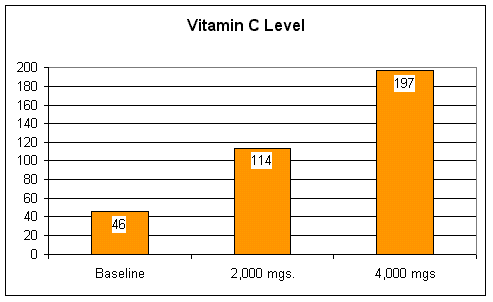
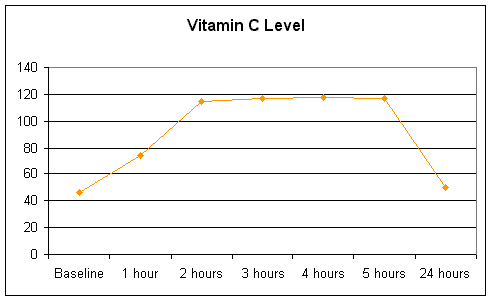
Now, when you take Vitamin C orally, your body will absorb only as much Vitamin C as it needs at that particular time. Unabsorbed Vitamin C will remain in the intestines, where it will draw in water, and the result will be loose stools and/or diarrhea. There are specific circumstances and specific disease states where a patient might benefit from an intentional "GI overdose" of Vitamin C as a detoxifying procedure (this is termed the "C Flush"), but from the cardiac perspective, we don't want you to experience any Vitamin C related GI tract symptoms. If a given dose of Vitamin C is giving you trouble, then the dose is too high for you. Split the dose into more frequent, smaller servings, or cut back the total mgs. Dosing "to GI tolerance" involves taking 1000 mg of Vitamin C every hour, up to the point where loose stools develop, and then taking the total dose minus 1000 mg as your maintenance daily dose, split into 2 to 3 servings. Of interest, healthy people "can tolerate" less Vitamin C than can unhealthy patients. The sicker people are experiencing greater free radical stress, have lower Vitamin C levels, and their body's are delighted to "soak up" all the Vitamin C that they can take. If you are healthy and can take, say 3000 mgs of Vitamin C each day without difficulty, when you have the flu you will be able to tolerate 2 to 3 times that amount, as your body is then under stress and will need more Vitamin C and will absorb more Vitamin C.
You will hear that Vitamin C "goes right through you" to create "expensive urine". It is true that much of the Vitamin C that we take orally is excreted in the urine soon after we take it in, but much of the Vitamin C does enter our cells, and the Vitamin C that is excreted probably carried out an antioxidant or detoxifying chemical process while it was in transit within your circulation.
What about safety concerns? Well, the risk to you from oral Vitamin C is negligible. The old adage that Vitamin C causes kidney stones is probably not accurate (Vitamin C added to urine samples outside of the body causes oxalate crystals to form but Vitamin C taken orally or IV does not aggravate oxalate stone formation in the kidneys). If you have a rare disorder of hemoglobin function (G-6 PD deficiency, something that I have never encountered in an adult), then you should not take Vitamin C IV, but oral Vitamin C is not likely to be a problem. I gave myself 40,000 mgs of Vitamin C IV and then went out and ran 10 miles; here we're talking about 1-2,000 mgs taken orally - this stuff is safe. Vitamin C enhances iron absorption, and thus may be of additional value to menstruating women, but in men and post-menopausal women this is an area of potential concern. We need enough iron in our diet to make a normal compliment of red blood cells, but beyond that iron has negative health effects. Free iron, not participating in hemoglobin formation or another iron-requiring biochemical process, actually acts as a free radical, promoting the oxidation of LDL cholesterol and other intracellular and extracellular structures. Iron excess is associated with endothelial dysfunction, insulin insensitivity, and an increased risk for cardiovascular disease and adverse cardiovascular events. Iron binding therapy improves endothelial dysfunction, decreases the medication needs of previously iron overloaded diabetics, and in animal studies, decreases heart attack size. A genetic abnormality associated with excessive iron absorption from the GI tract, Hemochromatosis, is rare, and occurs only if you inherit the Hemochromatosis gene from both your mother and your father. However, the presence of one faulty gene, causing a moderate iron over absorption problem, is quite common. We can look for evidence of iron overload with a routine lab test (serum ferritin); if the value is above 100, I simply recommend that you donate blood on a periodic basis to the Red Cross. Then you can take all the Vitamin C that you want. This protocol gives you Vitamin C cardiac protection, keeps your ferritin level within the desirable range, and does good for others. It also does good for you; individuals who donate blood live 10 years longer than people who don't. If you are to undergo dental work, don't take Vitamin C that morning; the detoxifying effect of Vitamin C will metabolize the local anesthesia the dentist uses to numb your teeth, rendering your trip to the dentist a little uncomfortable. The recommendations on this webpage are general in nature, and assume the absence of important extra-cardiovascular problems. There are certain situations where your physician may not want you to take Vitamin C (i.e. dialysis patients, cancer patients undergoing therapy), so if any question exists, ask your doctor
What type of Vitamin C should you take? Vitamin C's chemical name is ascorbic acid, and yes, if you have a sensitive stomach, it can cause some irritation. If plain Vitamin C bothers you, then a "buffered" or "mineral ascorbate" might work better for you. Bioflavonoids are "Vitamin C helpers"; they shepherd Vitamin C into the body, have beneficial effects of their own, and synergize with Vitamin C (Vitamin C and Bioflavonoids taken together decrease abnormal bleeding related to coumadin anticoagulation better than do Vitamin C or Bioflavonoids taken alone). It is worth it to pay a little more for Vitamin C complexed with Bioflavonoids. "Esterified" Vitamin C is better absorbed than regular C; Esterified C is typically well tolerated but does cost more. My own patients take a buffered Vitamin C complexed with GMS-Ribose and biopterin to enhance absorption. The key here is not which Vitamin C preparation you take, but simply to take Vitamin C. Find a preparation that you tolerate well and that you can easily afford, and then take it. Remember:
Vitamin C that sits on the shelf will not lower your 10-year mortality rate by 43%
13. Vitamin C as a member of your Antioxidant Defense Team - Understanding Nutritional Medicine
My goal with the Tip of the Month webpage series is not to get you interested in taking Vitamin C, but rather to convince you of the importance of incorporating the principles of nutritional medicine into your (what can be a long and healthy) life. For purposes of clarity and to make a point, on this page we focused only on Vitamin C.
In this section I want to point out that Vitamin C is not a magic bullet, but merely one component of your body's anti-oxidant, anti-inflammatory, anti-cancer, and anti-infective defense systems. Vitamin C works best as a player on your antioxidant defense team, a player with healthy teammates, and reserves at each position. Please realize that a multitude of free-radical inflammatory stressors are working on us, trying to harm us, at multiple levels in different organ systems. Vitamin C is a great general anti-oxidant, but Vitamin C alone has no effect on many of these toxic free radicals. Vitamin C can also be used up; spent Vitamin C, however, can be "recharged" by Bioflavonoid vitamins, that is if Bioflavonoids are present within your circulation. Vitamin C is also tasked with the responsibility to "recharge" spent Vitamin E, and Vitamin E in turn works within the cell with Lycopene, Beta-carotene, and Co-Enzyme Q10. To play great defense, a football team needs 11 players. High doses of Vitamin C alone may constitute a great front line, but without the other anti-oxidants and nutritionals to serve as line backers, cornerbacks, and free safeties, the Vitamin C only team is not going to stop the run and its not going to stop the pass. Vitamin C alone, no matter how much you take, is not going to sack coronary disease at an early stage. Mother Nature expects us to take in 96 nutrients every day. The key here is to take Vitamin C, along with the other nutritional substances that you need. You are going to hear about the specific health-promoting effects of individual nutritionals in specific disease states (Co-Enzyme Q10 and Glutathione in Parkinson's disease, Lutein and Zeaxanthine in macular degeneration, Lycopene in prostate cancer, etc.), and indeed these benefits are real and important, but please remember that these individual nutritionals, like Vitamin C, work best when combined with the other vitamins and minerals that you need. So take Vitamin C, but take Vitamin C as a component of a broad-spectrum vitamin and mineral supplement. A one-a-day multi, such as the commercial preparations advertised on TV, is better than nothing, but a one-a-day is not going to provide you with the protection you need. To get enough Vitamin C and Vitamin E to prevent heart disease, enough Calcium to prevent osteoporosis, enough B Vitamins to keep your Homocysteine level down, etc., you need to take a 4 to 6 tablet-a-day multinutritional. The table below lists the contents of a representative preparation. Most of my patients take Amni Preventive V, compounded by Douglas Labs; other good preparations are Twin Labs Mega Six and Carlson's Cardirite. Every major nutritional company has such a multinutritional, and the people at area health food stores can help you here. Expect to pay $20-30 per month for a good preparation. Cost is always an issue, but also keep in mind the cost to you, your family, and to our society if you sustain an adverse health event that could have been prevented (As Vitamin C decreases 10-year event rate by up to 50%, consider what would happen to health care costs if every American adult with mild to moderate atherosclerosis took 1000 mg/day.).
| Calcium |
500-1000 mg |
Magnesium | 400-600 mg | Manganese | 15 to 25 mg |
| Zinc | 15-25 mg | Chromium | 150-200 mcg | Selenium | 150-200 mcg |
| Vitamin A | 5,000 IU | Vitamin D | 50-200 IU | Vitamin E | 400-800 IU |
| Vitamin C | 1,000-2,000 mg | Biotin | 200-300 mcg | Iodine | 100-200 mcg |
| Molybdenum | 50-100 mcg | Choline | 50-100 mcg | Thiamine | 50-150 mg |
| Riboflavin | 25-50 mg | Pyridoxine (B6) | 15-25 mg | Vitamin B12 | 50-200 mcg |
| Niacin | 25-100 mg | Niacinamide | 50-150 mcg | Folic Acid | 400-800 mcg |
| Pantothene | 250-500 mcg | PABA | 50-100 mg | Bioflavonoids | 50-150 mg |
| Copper | 1-2 mg | Boron | 0.5-1 mg | Beta Carotene | 10,00-20,000 IU |
This principle of "team" nutritional medicine makes perfect sense, but it took me a long time to understand it. Unfortunately, many researchers and health care providers still don't. The studies reviewed on this webpage reveal the remarkable health promoting power of Vitamin C: the need for repeat angioplasty is decreased over 50%, 10-year mortality is blunted by 43%, etc. Now, there have been studies showing Vitamin C to have no effect on a cardiovascular parameter, and one highly publicized study suggested that Vitamin C as a monotherapy hastened progression of carotid artery plaque (Dr. Salonen's study, 6a on this page, showed just the opposite effect but the media never reported it), and the media is prompt to report the "conclusion" that "Vitamin C is of no value". Now, how can nutritional agents like Vitamin C "work" in one study and "not work" in another?
To answer this question, let's look at the "Finnish" study, which was reported by the media as evidence that Vitamin E was of no value. Middle-aged Finnish men, who had smoked on average for 36 years, received either placebo or 50 mg of Vitamin E, every day over 6 years. Diet was not changed, and only 1/5th of the men quit smoking. The researchers found no difference in 6-year cardiac event or lung cancer rates between the Vitamin E and placebo groups. The researchers themselves did not conclude that Vitamin E "didn't work", but that Vitamin E at this dose in long-term smokers had no effect on new-onset cardiovascular disease and lung cancer ($20,000,000 was spent on this study so they had to conclude something), while on the evening news you were told that Vitamin E is of no value. The truth is, that this study, which was planned out 15 years ago, without the knowledge that we have today, was a poor use of $20,000,000. You know that smokers are low in Vitamin C, but the subjects in the Finnish study did not receive Vitamin C, so they remained C deficient. The Finns drink a lot, and alcohol uses up Vitamin E, but the subjects received only a low dose (modern studies use 400-800 IU of Vitamin E). Finns are notoriously deficient in Selenium (without which all the Vitamin E in the world cannot protect you), and in Essential Fatty Acids (a whole other arm of our defense system). Giving these nutritionally deficient, inveterate smokers, 50 mg of Vitamin E and expecting a 6-year health benefit is like giving one canteen of water to a man dieing of thirst in the middle of the Sahara. If they gave the smokers 1000 mg of Vitamin E, it still might "not work". High-dose Vitamin E monotherapy in long-standing smokers is like putting a Michelin on a car with three other flats; despite the Michelin the car won't move. In drug medicine we give a drug and expect an effect. In surgery we take out your inflamed appendix and expect you to get better. In nutritional medicine we need to optimize your nutritional status so your physiology can get you better.
Modern studies are beginning to incorporate this principle into their design. The subjects will receive either placebos or a "cocktails" of nutritionals. These studies may also allow for dosage adjustment of the nutritional, to achieve a certain biological effect. When a cholesterol-lowering drug is being evaluated, the research protocol typically allows for the drug dose to be adjusted to achieve a certain biological effect, such as a LDL cholesterol of 100 mg/dl or below. The researchers take in to consideration that different people will need different doses of the drug to obtain a given target cholesterol level. When looking at the effect of a specific BP-lowering drug on future cardiac event rate, the dose of the drug is adjusted to achieve a target BP, such as 140/90. In real nutritional medicine, we give anti-oxidants to obtain an anti-oxidant effect. We can measure anti-oxidant levels in the blood, or treatment target biomarkers like the ratio between oxidized and unoxidized LDL cholesterol, and then give you enough of the anti-oxidant under study to achieve this effect, but in the "mainstream" or "university" research studies on nutritional supplementation carried out to date, dosage adjustment was not allowed. We don't give nutritional therapies the fair chance that we give to drugs. We instead give you one dose of one antioxidant and see if it has an effect on future event rate. This is like doing a BP-lowering drug study with a drug dose that lowered the BP in only 1/2 of the subjects; how can you expect an inadequate drug dose to have a favorable effect? How can you expect an inadequate antioxidant dose to have a favorable effect? Future studies will incorporate these principles into their design, but it is important that you understand why some of the well publicized "negative" studies, were really "flawed" studies, and thus misleading.
If you are told that nutritional medicine "doesn't work", "is dangerous", or simply gives you "expensive urine", challenge whoever made such a statement to back it up with facts. I think that nutritional medicine is great medicine, and I back it up with facts. Ask the critics for facts; ask the critics to give you scientific studies showing that vitamin supplementation in reasonable doses is dangerous. Also ask them: "Are you aware of any drugs that decrease 10-year mortality by 43%?"
This webpage, and this entire website for that matter, is simply a regurgitation of the medical literature, punctuated with patient outcome data from my practice, where we integrate nutritional medicine in with invasive cardiology, drug therapy, and EECP. Here I will vary from this theme and speak from personal experience, as to how the principles of nutritional medicine have altered my practice of medicine, and what I feel to be my responsibility to my patients. In my mid-30s, I believed that vitamin therapies were ineffective to dangerous. I believed this because this is what my professors had told me. They believed this because this is what they had been told. There was no science involved here, just opinion that had been passed on from professor to student. At that point, I believed in a drug and invasive approach to cardiovascular disease. I spent the majority of my time in the hospital, doing invasive procedures on cardiac patients. I wound up being tied with two older MDs as the leading admitter to the cardiology service of my primary hospital, and for this I was richly rewarded. It did begin to dawn on me that I was often doing these invasive procedures over and over on the same patient; it began to dawn on me that invasive procedures alone were not the ultimate answer to the needs of my patients, but I didn't know what else to do. One day a persistent patient, a retired Army colonel who wouldn't take "no" for an answer, pressed upon me a research paper that discussed the benefits of antioxidant vitamins in cardiac patients. He dogged me until I finally read the paper. The paper made sense; it talked about how antioxidants actually addressed the cause of my patients' blocked arteries. The drug and invasive medicine that I had been practicing only addressed the consequences. Wow, now I could treat the causes of cardiovascular disease, not just the consequences. In 2003 this doesn't sound like much of a revelation, but it was to me in the late '80s and early '90s. I began "reading up" in the area of nutritional medicine and began to give talks on nutritional medicine to my patients. Nearly all of my personal patients began taking a multivitamin, and......... my admitting rate fell like a rock. All of a sudden I was seeing my patients over and over again in the office, as opposed to over and over again in the hospital. Here's an interesting story that makes a point. One day, around 12 years ago, all 8 beds in the St. V's CCU were occupied by patients that I was managing (I got home awfully late that night). Now, if I walk through the CCU on my way out of the hospital, the staff might stop me and ask for an ID, because I haven't admitted a patient to the ST. V's CCU in several years. I'm still doing heart catheterizations, and my patients undergo angioplasty, stent placement, and bypass surgery if I think they need it, but these patients, just as are every other patient that I see, are also treated nutritionally. My patients are doing much better, and this is incredibly gratifying. In my opinion, the future of cardiovascular medicine, and medicine in general for that matter, will involve integrating the principles of nutritional medicine (termed "alternative medicine" by our critics) with those of orthodox medicine (termed "profiting off the suffering of others without lifting a baby finger to address the underlying cause", by nutritionally oriented doctors who are tired of being badmouthed by the "mainstream"). There has been a great deal of bitterness expressed by both camps; I have experienced this directly, and I don't like it. The bitterness and badmouthing seems to be receding. I give lectures at alternative medicine meetings as to how their "alternative" patients can benefit from angioplasty and bypass surgery, and when and if it is appropriate for them. All of my "orthodox" cardiology journals are publishing studies describing the benefits of nutritional interventions (look at where the majority of the studies abstracted on this web page came from). Soon we will not have "alternative medicine" and "orthodox medicine"; instead we will have "great medicine", where the principles of nutritional medicine will stand side-by-side, and support, the principles of pharmacologic intervention and surgery. Hopefully this union will occur in time to help you and your family, and before our current approach bankrupts the Medicare program.
14. Randomized, Double-Blind, Placebo-Controlled Study of Ascorbate on the Preventive Effect of Nitrate Tolerance in Patients With Congestive Heat Failure. Watanabe, H, et al. Circulation 1998;97:886-91.
This is a complicated abstract, but if you are taking a long-acting NTG preparation you might want to read on, as:
Long-acting Nitrates Cause Endothelial Dysfunction and Increase Long-term Cardiovascular Event Risk,
and
Vitamin C Reverses Nitrate-Induced Endothelial Dysfunction
Sublingual or under-the-tongue Nitroglycerin (NTG) has been a mainstay of angina therapy for over 50 years. When you experience anginal discomfort you can simply place a NTG tablet under your tongue, and voila, your chest pain resolves. How does NTG work?
When you take NTG, what you are really doing is giving your circulation a jolt of Nitric Oxide, the vasodilating, anti-vasospasm, anti-platelet aggregation vasochemical that healthy arterial endothelial cells manufacture from arginine. The problem is that your endothelial cells are no longer healthy; you're not making enough Nitric Oxide so you need NTG as an exogenous source of Nitric Oxide. This is OK for you; your chest pain resolves, the exogenous Nitric Oxide is quickly metabolized, and no harm is done to your physiology.
If sublingual NTG is so helpful, then why not place patients on a long-acting NTG program? This makes intuitive sense. When I was an intern, we would apply "Nitro paste" to the patient's skin. This was a cream that contained a defined amount of NTG, which would seep into your skin over four hours, providing you with a 4-hour NTG effect. A sustained-release NTG tablet came out, Isosorbide Dinitrate, a less messy approach that provided 6-hour NTG "protection". The "NTG patch" came out around 15 years ago, a Band-Aid-like drug delivery system which can release NTG through the skin and into the circulation for up to 24 hours.
Patients benefited from these preparations; their angina improved and they didn't need to take as many under-the-tongue NTG tablets. Funny thing though, we began to see that after a period of time, a given dose of sustained-release or patch NTG "no longer worked". If we increased the dose, the patient's symptoms would again quiet down, but only for a period of time. This didn't make much sense to us. We didn't know why the long-acting NTG preparation "no longer worked"; we said that the patient had developed "Nitrate Tolerance".
Another problem with long-acting nitrates came up in the cardiology literature. Outcome studies, where the researchers correlate patient characteristics (i.e. cholesterol level), or treatments (i.e. bypass surgery vs. angioplasty) with the patients' health status years later, came out showing that patients on long-acting nitrates did worse, long-term, compared to patients who were not taking long-acting nitrates. My own analysis of this fact, 10 years ago, was that patients who required long-acting nitrates were sicker to begin with, and thus it made sense that their long-term outlook would be worse. I was wrong here - the long-acting nitrates were actually making the patient worse. The long-acting nitrates reduced the patient's symptoms, but at the same time aggravated their underlying endothelial dysfunction. Please recall Roberts' Dictum: As goes the endothelium, so goes the patient. Let me explain (and also see section 7: Vitamin C helps with blood pressure control).
It is the job of Nitric Oxide Synthase, an enzyme present within the endothelial cells that line our arteries, to convert Arginine, an amino acid obtained in our diet, into Nitric Oxide, our primary vasodilatory and vasoprotective angiochemical. If Nitric Oxide Synthase is not busy converting Arginine into Nitric Oxide, then it will start converting Oxygen into the free radical Superoxide. Superoxide, in turn, degrades Nitric Oxide. Superoxide thus is an anti-Nitric Oxide. Superoxide causes our blood vessel to constrict and increases platelet stickiness. In health, there is a balance between Nitric Oxide and Superoxide production. When Nitric Oxide - Superoxide production goes out of balance, then we develop cardiovascular disease. It turns out that diabetes, hypertension, smoking, inflammation, elevated homocysteine, Lp(a), and many other cardiovascular risk factors, block the conversion of Arginine into Nitric Oxide, and thus promote the conversion of Oxygen into Superoxide. These risk factors cause cardiovascular disease by putting Nitric Oxide-Superoxide production out of balance, causing endothelial dysfunction, which in turn leads to atherosclerotic blockages and adverse events, such as stroke or heart attack.
Now, when you take a long-acting NTG preparation, you are constantly bathing your circulation, and thus the endothelial cells lining your arteries, with Nitric Oxide, derived not in the normal fashion from dietary arginine, but from the drug NTG. Nitric Oxide levels will be high, relieving your symptoms, but in the presence of this artificially high Nitric Oxide level, the Nitric Oxide Synthase enzyme within your endothelial cells will stop producing Nitric Oxide from Arginine. Mother Nature wisely gave us a "negative feedback" system, designed to prevent the over production of Nitric Oxide; when Nitric Oxide levels are high, then production of Nitric Oxide will fall off, just as your air conditioning system will turn off when room temperature falls to the programmed, desired level.
Now, if Nitric Oxide Synthase stops converting Arginine into Nitric Oxide, it will immediately "switch over", and start converting Oxygen into Superoxide. Superoxide levels will rise, and will degrade or "neutralize" the Nitric Oxide that you are receiving from your long-acting NTG preparation, as well as any Nitric Oxide that your endothelial cells are still making. So all of a sudden there isn't enough Nitric Oxide floating around in your circulation, and your symptoms recur, so we increase the dose of your long-acting NTG. This helps for a little while, but inevitably the endothelial cells, which are no longer making any Nitric Oxide, kick out more Superoxide, which degrades more drug-derived Nitric Oxide, and your symptoms come back again. We call this "Nitrate Tolerance", but it is really drug induced endothelial dysfunction, a bad thing. Our intent here was good, but in relieving your symptoms with long-acting nitrates we are damaging your endothelium, actually increasing your risk for future adverse events. This is the physiologic explanation underlying the fact that the use of long-acting nitrates is associated with an increased future event rate.
So, we have identified a problem: Long-acting nitrates cause endothelial dysfunction and this increase our risk for a future adverse event. Well, what can we do about it? Are there means by which we can stay on the long-acting NTG, enjoying the pain relief that these drugs provide, without damaging the endothelium, without increasing our future event risk?
The biochemical problem that we face in the situation of "Nitrate Tolerance" is really an excess of Superoxide, a free radical, an oxidant. In a test tube situation, we can degrade or "neutralize" free radicals by introducing an antioxidant. The same situation holds true in our bodies, and our biochemistry prefers, you guessed it, Vitamin C for this purpose. Clinical studies have shown us that Vitamin C and N-Acetyl Cysteine (another antioxidant nutritional that many of our patients take) will prevent Nitrate Tolerance. When these agents are co-administered, a defined dose of a long-acting nitrate remains effective, and the patients do better - they have fewer adverse events! To be fair to the pharmaceutical industry, drugs that provide an antioxidant effect within the endothelial cells, such as statin lipid-lowering agents and Tissue Specific ACE Inhibitors (BP lowering agents that improve endothelial function) also protect against Nitrate Tolerance. I've let the cat out of the bag, but Watanabe's representative study is abstracted below:
20 patients hospitalized with congestive heart failure were randomized to receive:
a) A fixed dose of IV NTG and a IV placebo solution, or
b) A fixed dose of IV NTG and a fixed, weight-based dose of IV Vitamin C (5000 mg for an average size man) over 24 hours.
Baseline measurements were carried out before either regimen was administered:
a) A pressure recording catheter was passed into the right heart of each patient and used to record the Pulmonary Capillary Wedge (PCW) pressure, which reflects the level of backed up fluid pressure experienced by the lung. A normal PCW pressure is 5-10 mmHg. Heart failure patients who are doing well typically have a PCW of 10-15, while decompensated or symptomatic patients have a PCW above 20. A goal of treatment is to decrease the PCW to below 15. Systolic blood pressure (the upper number in your BP reading) was also monitored.
b) Vitamin C and Vitamin E levels were obtained, along with
c) Platelet cGMP levels: When platelet cGMP (cyclic Guanylate Monophosphate) levels are high, the blood platelets are less sticky, less likely to initiate a clot within your arteries. A high platelet cGMP level correlates with high endothelial Nitric Oxide production, and reflects the same, healthful biochemistry. Platelet cGMP can thus be considered a marker not just of healthy platelet function, but of healthy endothelial function.
IV NTG was then administered to the subjects in both groups; the dose was increased until the PCW pressure fell 30% from baseline; this fixed dose of NTG was continued for the remaining 18 hours of the study (In this situation, the development of Nitrate Tolerance is anticipated). After the NTG dose had been fixed, a placebo solution was begun in group a) patients, while in group b) IV Vitamin C was begun. PCW pressure measurements, along with determinations of platelet cGMP and blood Vitamin E and Vitamin C levels were then obtained following 6, 12, and 18 hours of IV NTG with either a) placebo or b) Vitamin C. Let's see what effect Vitamin C had on these parameters of cardiovascular and endothelial function.
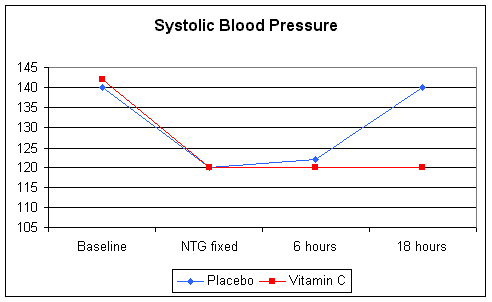 In
both groups the pre-treatment, baseline systolic blood pressure (SBP) was around
140 mmHg. IV NTG was then initiated, and the dose increased to obtain a
SBP of 120; this was the "NTG fixed" time point. At 6 hours,
without a change in NTG dose, SBP remained decreased in both groups - NTG
tolerance had not yet occurred. But at 18 hours, NTG tolerance had
occurred in the placebo group; despite ongoing IV NTG therapy the SBP had
increased back to the pre-treatment value of 140. At this point the IV NTG was
having no therapeutic effect (actually it was causing oxidative stress and
endothelial dysfunction). Vitamin C did not interfere with the IV NTG
effect; SBP fell to 120 mmHg, just as in the placebo group.
Co-administration of Vitamin C did prevent NTG
In
both groups the pre-treatment, baseline systolic blood pressure (SBP) was around
140 mmHg. IV NTG was then initiated, and the dose increased to obtain a
SBP of 120; this was the "NTG fixed" time point. At 6 hours,
without a change in NTG dose, SBP remained decreased in both groups - NTG
tolerance had not yet occurred. But at 18 hours, NTG tolerance had
occurred in the placebo group; despite ongoing IV NTG therapy the SBP had
increased back to the pre-treatment value of 140. At this point the IV NTG was
having no therapeutic effect (actually it was causing oxidative stress and
endothelial dysfunction). Vitamin C did not interfere with the IV NTG
effect; SBP fell to 120 mmHg, just as in the placebo group.
Co-administration of Vitamin C did prevent NTG
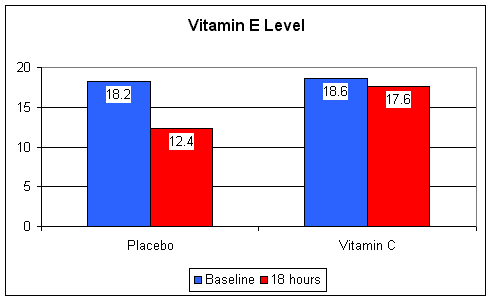 tolerance;
the SBP stayed low over the entire 18-hour study period.
tolerance;
the SBP stayed low over the entire 18-hour study period.
If IV NTG is causing free radical stress, then it should be "using up" our antioxidant defense forces, just as smoking does. The chart on your left shows that 18 hours of IV NTG decreased the patients' Vitamin E levels, while IV NTG administered along with Vitamin C did not. Why? Two reasons. Remember, our antioxidant defense forces function as a team defense. Vitamin C neutralized the free radicals generated by the IV NTG, and Vitamin C "regenerated" Vitamin E that was "spent" fighting any free radicals that slipped through Vitamin C's defense.
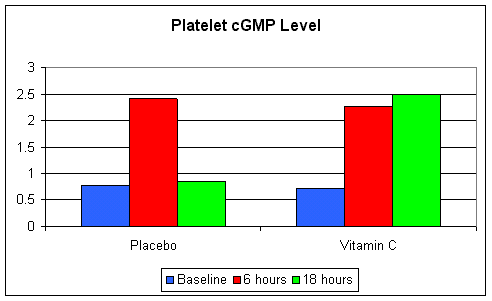 When
platelet cGMP levels are high, the blood platelets are less sticky, less likely
to form clots within your arteries. A high platelet cGMP reflects the same
biochemistry that leads to normal endothelial function. Most of our patients have a
low platelet cGMP level. That is why they are cardiac patients; their
endothelium is dysfunctional and their platelets want to clot. We want our
treatments to increase platelet cGMP, and NTG will do so. Here you can see
that platelet cGMP rose from baseline in both groups, but just as in the case of
SBP, NTG tolerance developed at 18 hours; platelet cGMP returned to the
pre-treatment baseline value - the platelets were sticky again. Here
again, NTG tolerance was prevented with Vitamin C; the beneficial effect of NTG
on platelet
When
platelet cGMP levels are high, the blood platelets are less sticky, less likely
to form clots within your arteries. A high platelet cGMP reflects the same
biochemistry that leads to normal endothelial function. Most of our patients have a
low platelet cGMP level. That is why they are cardiac patients; their
endothelium is dysfunctional and their platelets want to clot. We want our
treatments to increase platelet cGMP, and NTG will do so. Here you can see
that platelet cGMP rose from baseline in both groups, but just as in the case of
SBP, NTG tolerance developed at 18 hours; platelet cGMP returned to the
pre-treatment baseline value - the platelets were sticky again. Here
again, NTG tolerance was prevented with Vitamin C; the beneficial effect of NTG
on platelet
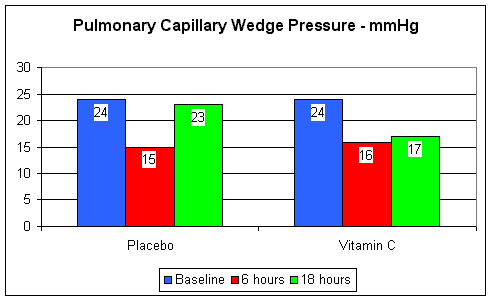
stickiness was preserved.
The PCW pressure reflects the degree of congestion within the lungs; it reflects the elevated intracardiac blood pressure that the lungs "see". The goal of treatment is to lower the PCW pressure, relieving lung congestion and thus the patient's symptoms. IV NTG worked well in both groups, at least at the 6 hours point. Then NTG tolerance set in, and by 18 hours the patients was "as good as not treated", unless of course, NTG tolerance was prevented by co-treatment with Vitamin C.
Long-acting nitrates, such as the IV NTG used in this study, produce free-radical oxidative stress, which eats through our antioxidant defenses, to rapidly neutralize that initial benefits that we obtained from the nitrate preparation. Even worse, the free radical stress induced by the long-acting nitrate shuts down normal, endogenous production of Nitric Oxide, worsening endothelial function, and by this mechanism increases our risk for adverse events in the future. This will not occur if you are also taking in adequate antioxidants, such as Vitamin C and N-Acetyl Cysteine, preferably as components of a broad-spectrum antioxidant program. Just how much Vitamin C should you take to prevent NTG tolerance? In this study 5000 mg/day was used. In a study of patients presenting with unstable angina, 4 week event rate on a NTG patch alone was 31%, while event rate in patients taking the NTG patch and 500 mg of N-Acetyl Cysteine was 13%. Extrapolating these studies to an individual patient is an individual judgment, but in my own patients I recommend 2000 mg Vitamin C or 1000 mg Vitamin C and 500 mg of N-Acetyl Cysteine (an antioxidant that also has lung and kidney protective benefits, which we discuss in the Antioxidant Vitamin lecture) in patients who are on long-acting NTG preparations.
Vitamin C prevents Nitrate Tolerance
15. Vitamin C is an inverse risk factor
Hundreds of studies have linked one's Vitamin C status, measured by dietary intake, blood or WBC Vitamin C levels, with a reduced risk for current or future cardiovascular disease and/or adverse cardiovascular events. Thousands of studies have likewise linked one's Vitamin C status with lower levels of the traditional cardiovascular risk factors. Vitamin C levels are inversely related to blood pressure, LDL cholesterol and triglyceride, and blood sugar values, and positively correlated with HDL and endothelial function. This principle holds true for entire societies. People living in regions where Vitamin C intake is typically high tend to have better looking risk factor assessments, and less cardiovascular disease, then do people living in low Vitamin C intake regions.
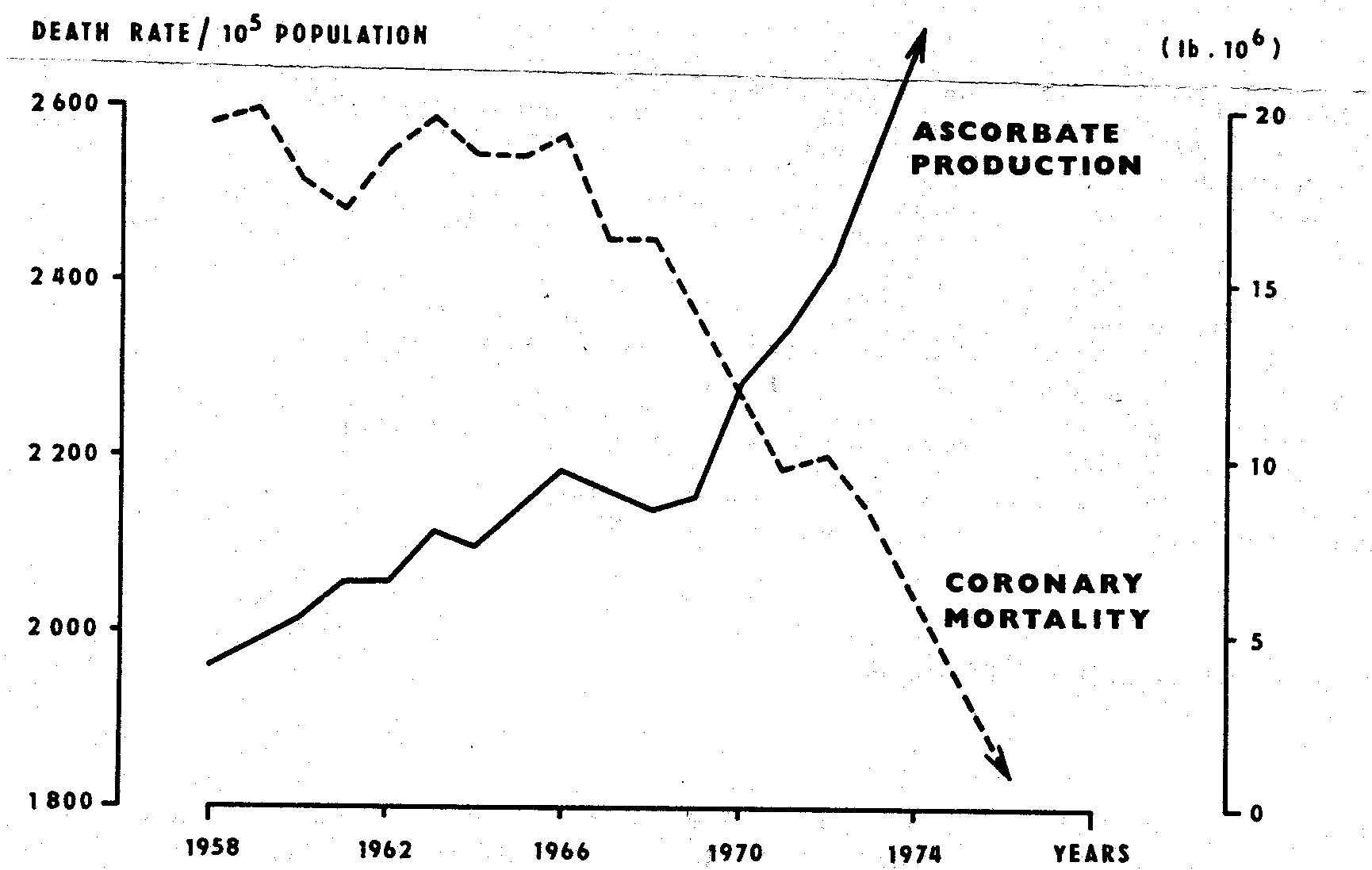 Nutritional
firms do not manufacture Vitamin C to let it sit on the shelves of stores;
rather they manufacture Vitamin C to keep up with consumer demand; thus Vitamin
C production mirrors Vitamin C consumption within a society.
Cardiovascular mortality has been falling in our society. Those of us
involved in the professional health care delivery system have taken full
responsibility for this feat. We haven't given you, the health care
consumer, much of the credit, and we've treated the nutritional medicine
advocates like pariahs (remember, not that long ago I was telling my patients
that Vitamin C was only good for "expense urine"). The
chart on the left demonstrates the relationship, a clearly inverse relationship,
between Vitamin C production in the United States, and coronary mortality in the
United States. Perhaps credit for this "remarkable turn around"
in the coronary death rate should be shared by you, the health care consumer,
who has been smart enough to spend a few pennies a day for "expensive
urine", and to the nutritional medicine advocates who were smart enough and
strong enough to have advised you to do so.
Nutritional
firms do not manufacture Vitamin C to let it sit on the shelves of stores;
rather they manufacture Vitamin C to keep up with consumer demand; thus Vitamin
C production mirrors Vitamin C consumption within a society.
Cardiovascular mortality has been falling in our society. Those of us
involved in the professional health care delivery system have taken full
responsibility for this feat. We haven't given you, the health care
consumer, much of the credit, and we've treated the nutritional medicine
advocates like pariahs (remember, not that long ago I was telling my patients
that Vitamin C was only good for "expense urine"). The
chart on the left demonstrates the relationship, a clearly inverse relationship,
between Vitamin C production in the United States, and coronary mortality in the
United States. Perhaps credit for this "remarkable turn around"
in the coronary death rate should be shared by you, the health care consumer,
who has been smart enough to spend a few pennies a day for "expensive
urine", and to the nutritional medicine advocates who were smart enough and
strong enough to have advised you to do so.
Vitamin C is an Inverse Risk Factor
16. Summary:
Vitamin C is a naturally occurring, water-soluble nutritional which plays a key role in our anti-oxidant, anti-inflammatory, and anti-infective physiologic systems. Not only is Vitamin C non-toxic, it is used by our body as a detoxifier. The key to cardiovascular health is to have good endothelial health. In the prevention and treatment of cardiovascular disease, Vitamin C's key role is to improve endothelial function. The benefits of Vitamin C on symptomatic status and patient outcome in essentially all of the cardiovascular disease states follows from this benefit at the level of endothelial function. The studies abstracted on this webpage document the following benefits of Vitamin C supplementation:
© At all stages, anatomic progression of atherosclerotic vascular disease is blunted
© Endothelial function improves
© In asymptomatic individuals with mild to moderate disease, 10-year event rate falls by > 50% and mortality by 43%
© Improved outcome following heart attack, bypass surgery, and balloon angioplasty
© Modest reduction in blood pressure and cholesterol values
© Protection against the disease-producing effects of Lipoprotein(a)
© Decreases blood lead levels
© Protects against nitroglycerin tolerance
Vitamin C provides these benefits for pennies a day, with negligible to nil toxicity at reasonable doses. Can you think of a drug or medical procedure that is essentially risk free, and decreases 10-year death rate by 43%? I can't think of a good reason for a non-iron overloaded American adult not to take Vitamin C (ideally as part of a broad-spectrum multinutritional) every day. If every American adult did take Vitamin C, my prediction is that health care-related costs would fall by at least a third, dollars that could then be shunted into preventive strategies. I hope you obtained information that will be of use to you from this Tip of the Month on Vitamin C. Future Tips will cover Arginine, Co-Enzyme Q, Fish Oil, and other nutritional agents that we use, along with EECP and pharmacologic and invasive cardiovascular treatments, to optimize the health outcomes of our patients. Our patient oriented lecture on Vitamin C and Lipoprotein(a) is available on tape; this can be borrowed by our patients at no cost. Non-patients can purchase the tape for $10 (All of our one session lecture tapes are available for $10; the two-session tapes cost $15. CDs containing the slides in PowerPoint format are available for many of the talks - please see the UPCOMING LECTURES section. Please feel free to attend our Spring '03 lectures series; the schedule will be posted in mid-February. The people who attend these lectures are a lot of fun; during the Q & A section they ask me difficult questions and really seem to enjoy my discomfort if I can't come up with an answer.
James C. Roberts MD FACC
last updated 1/25/03